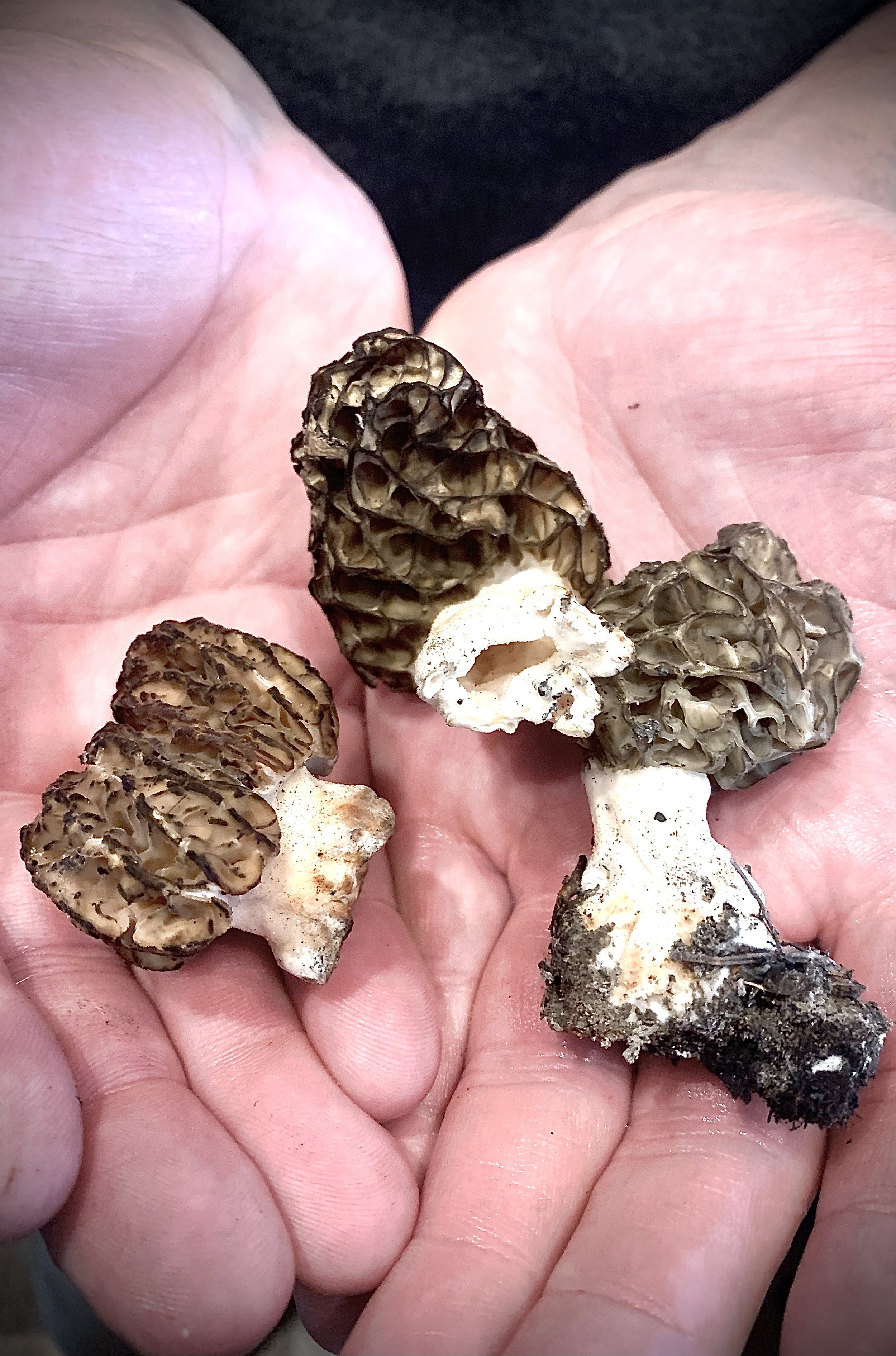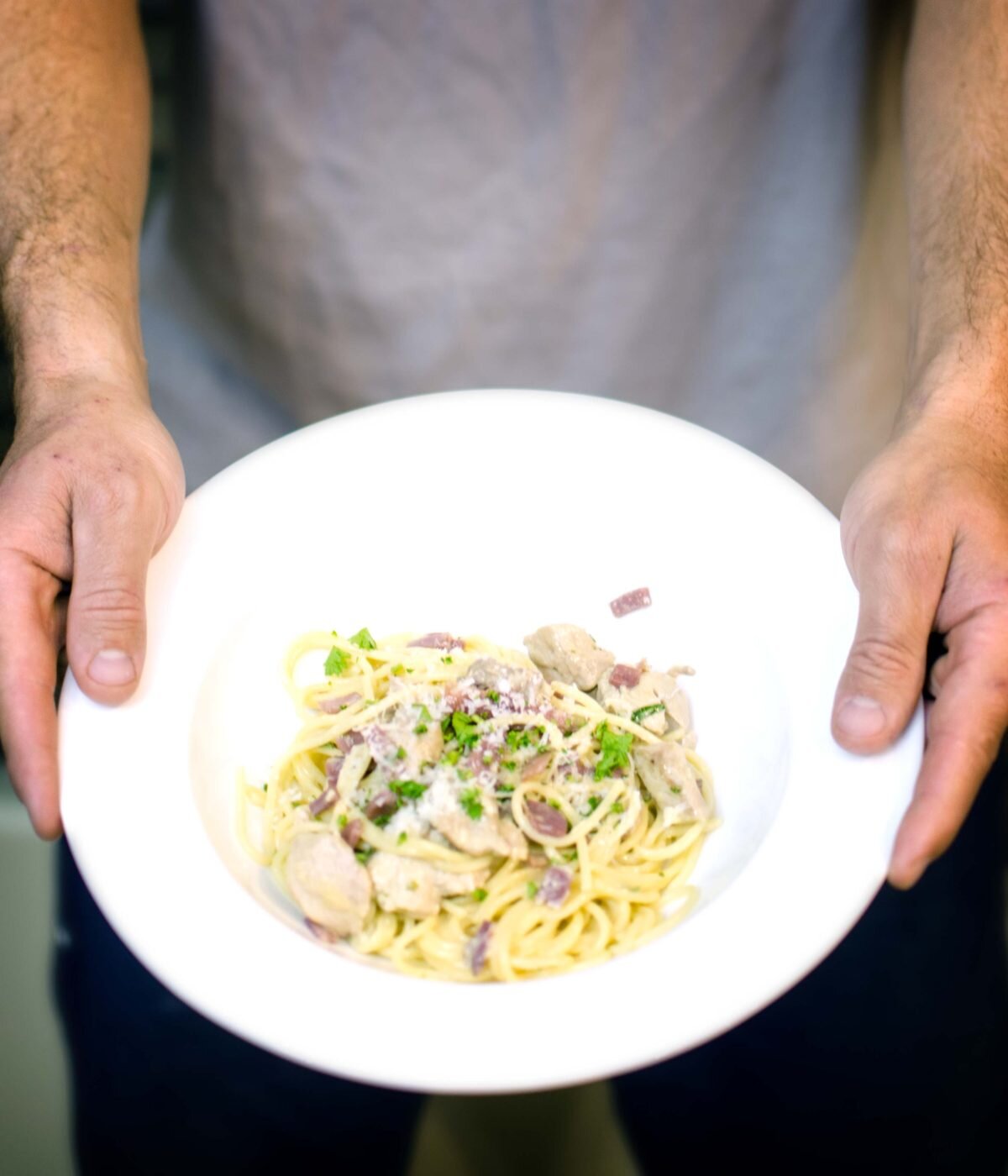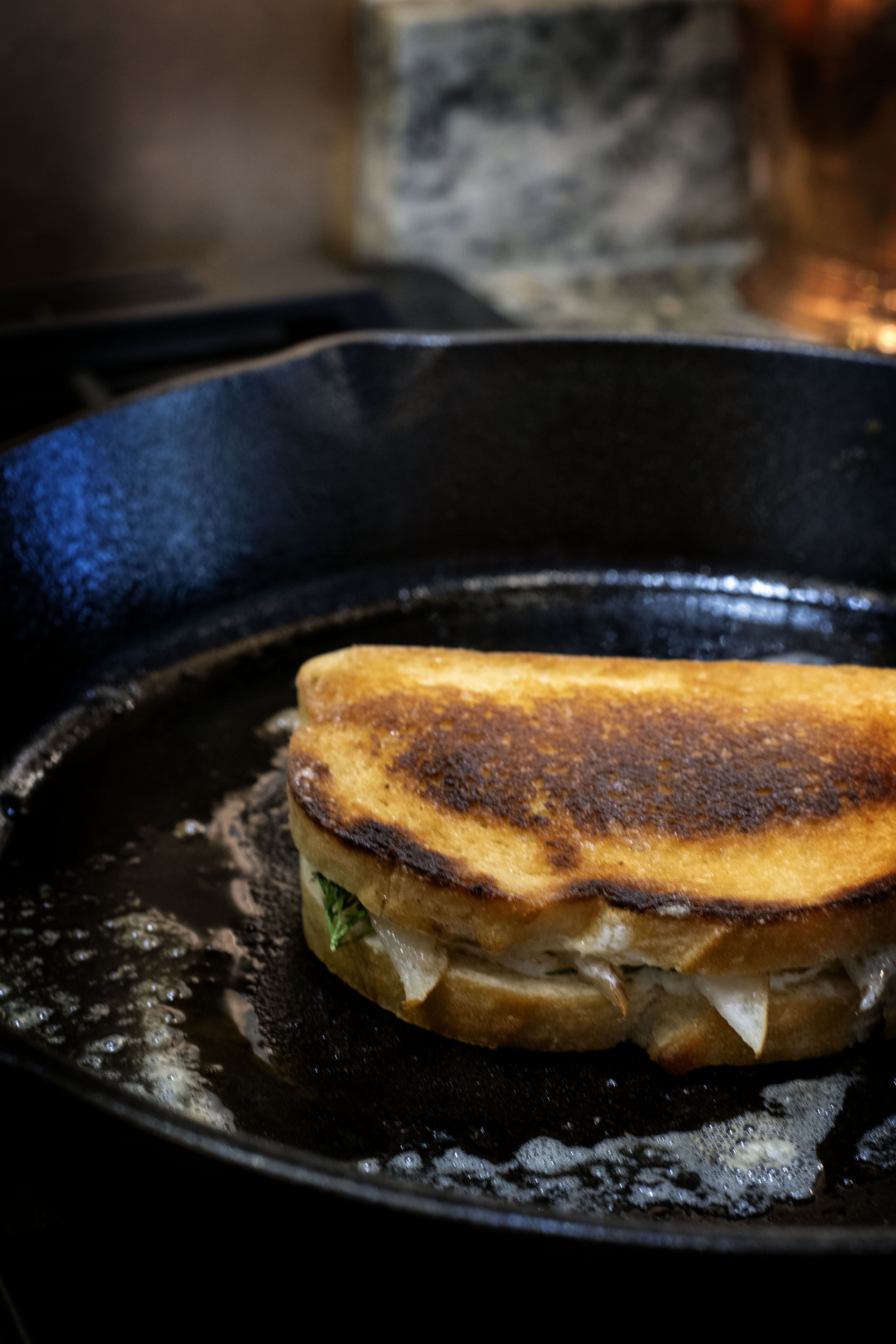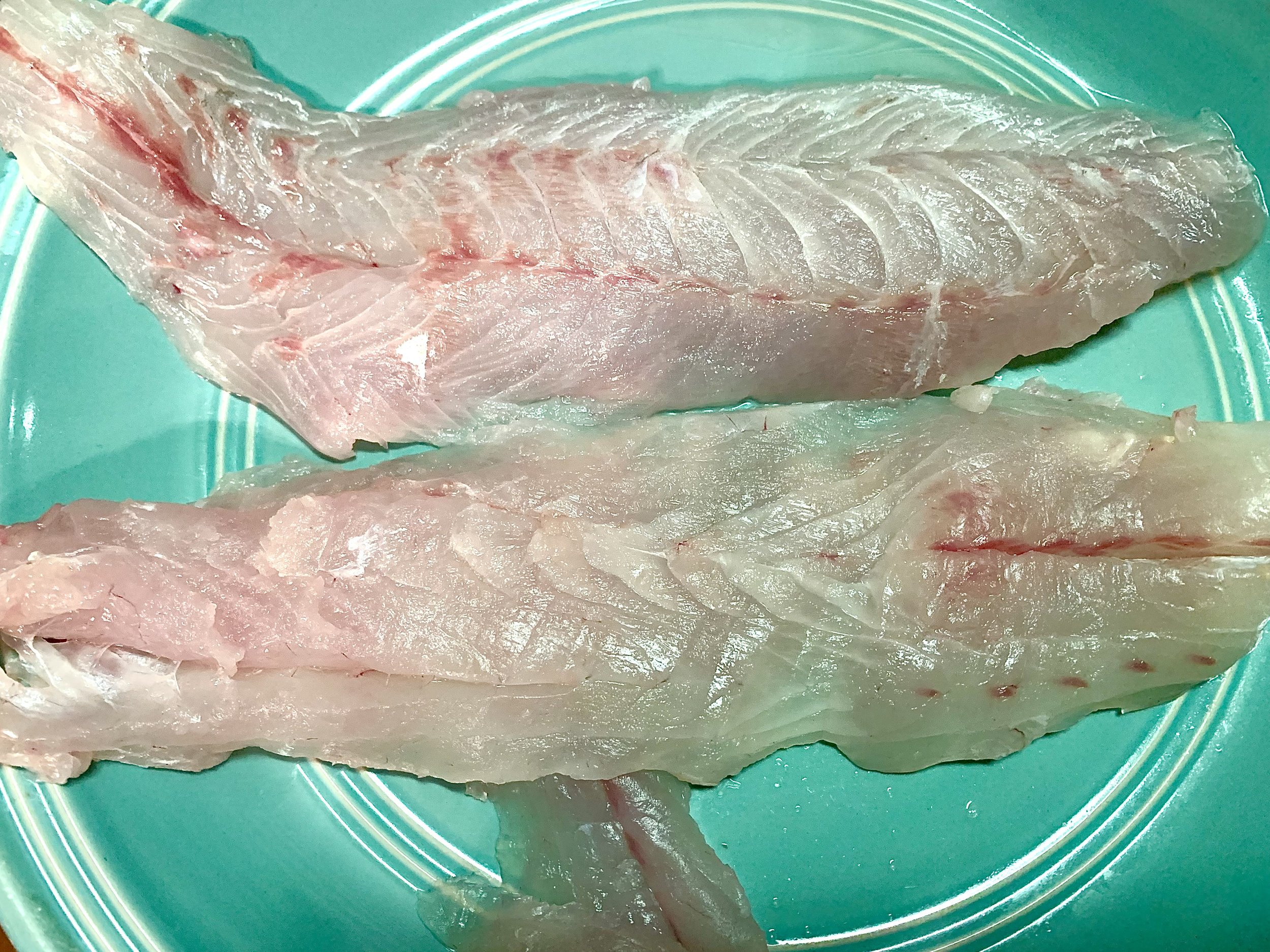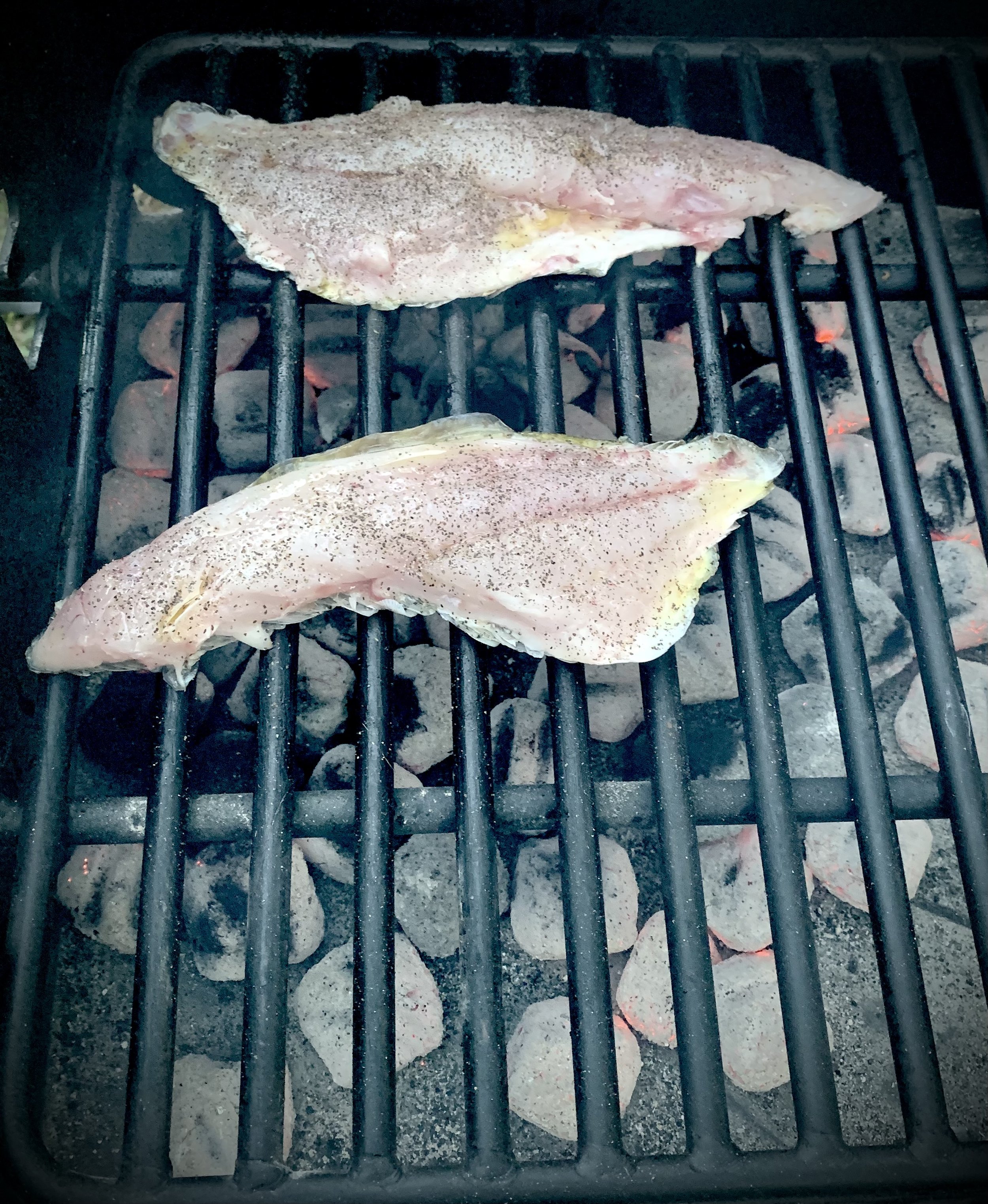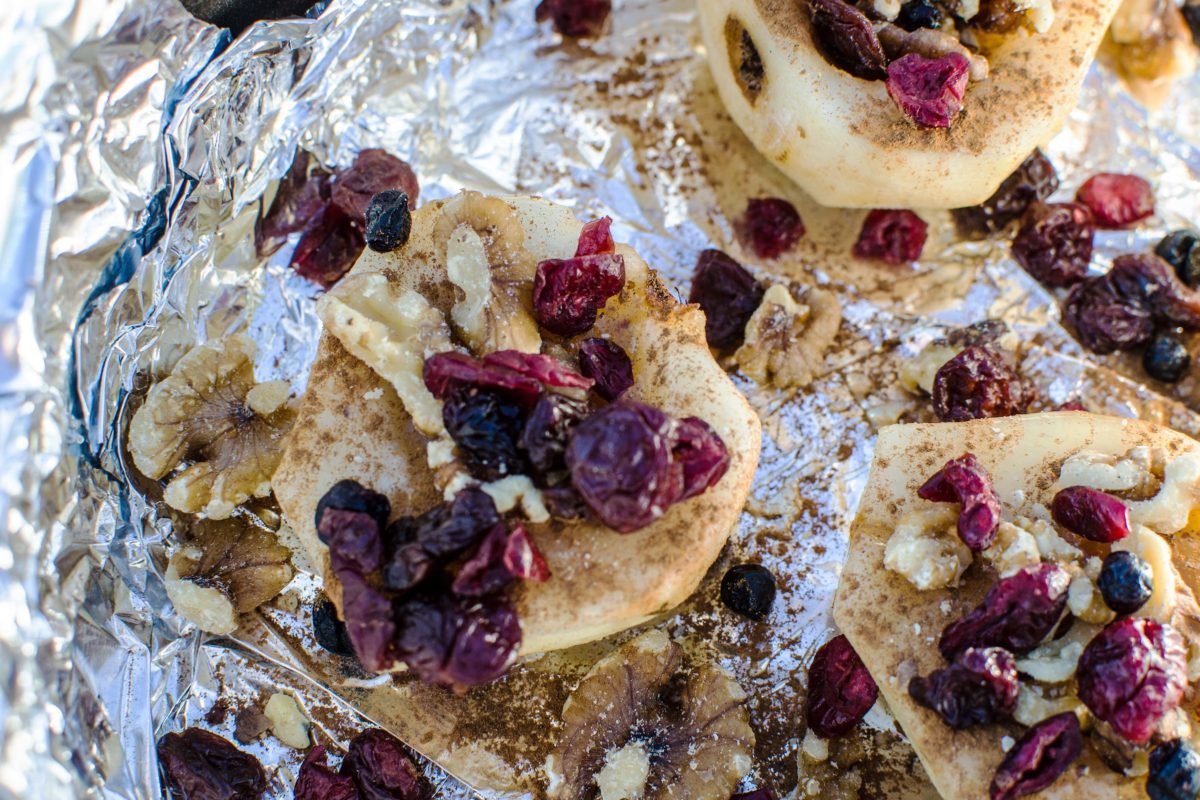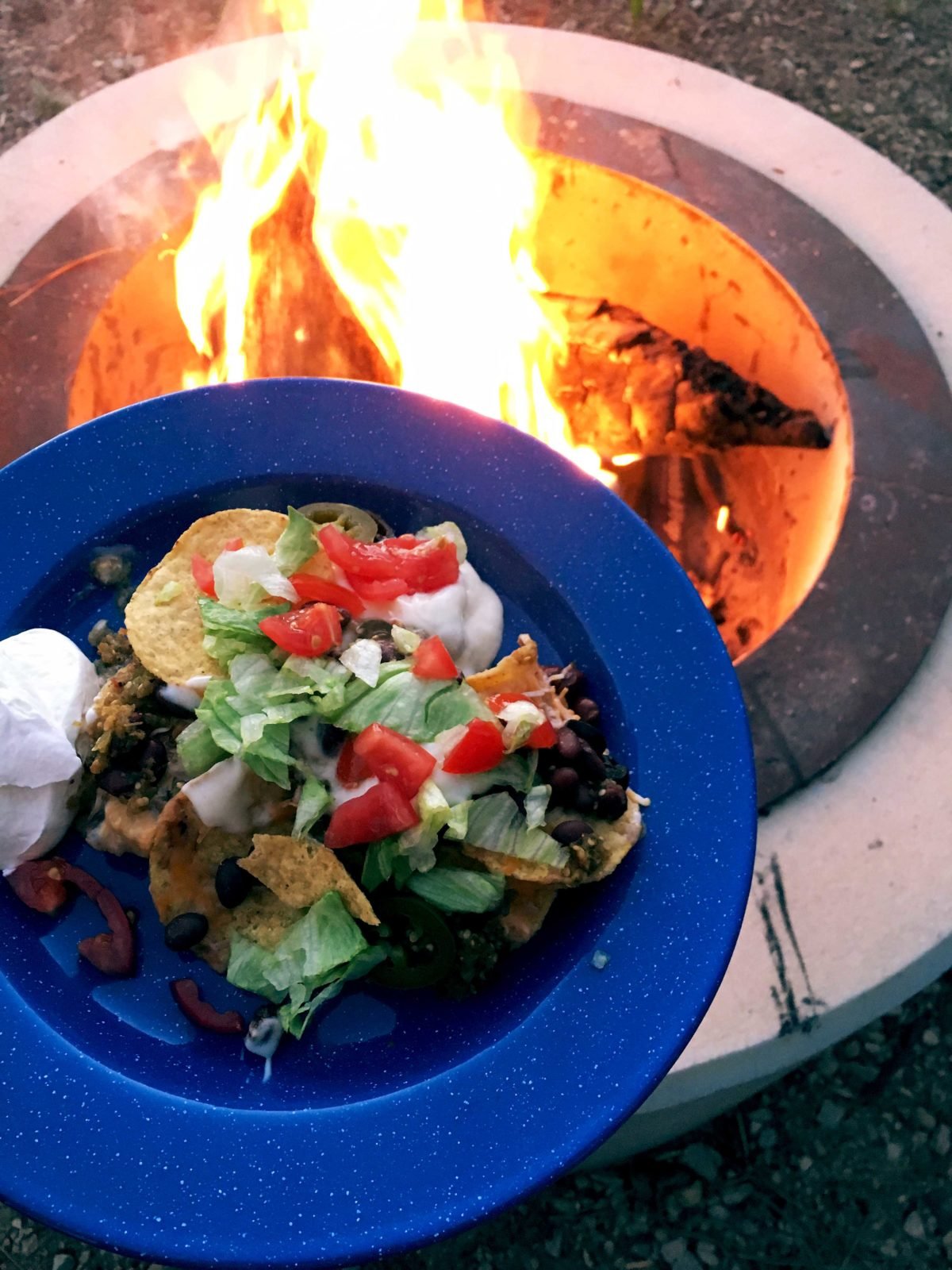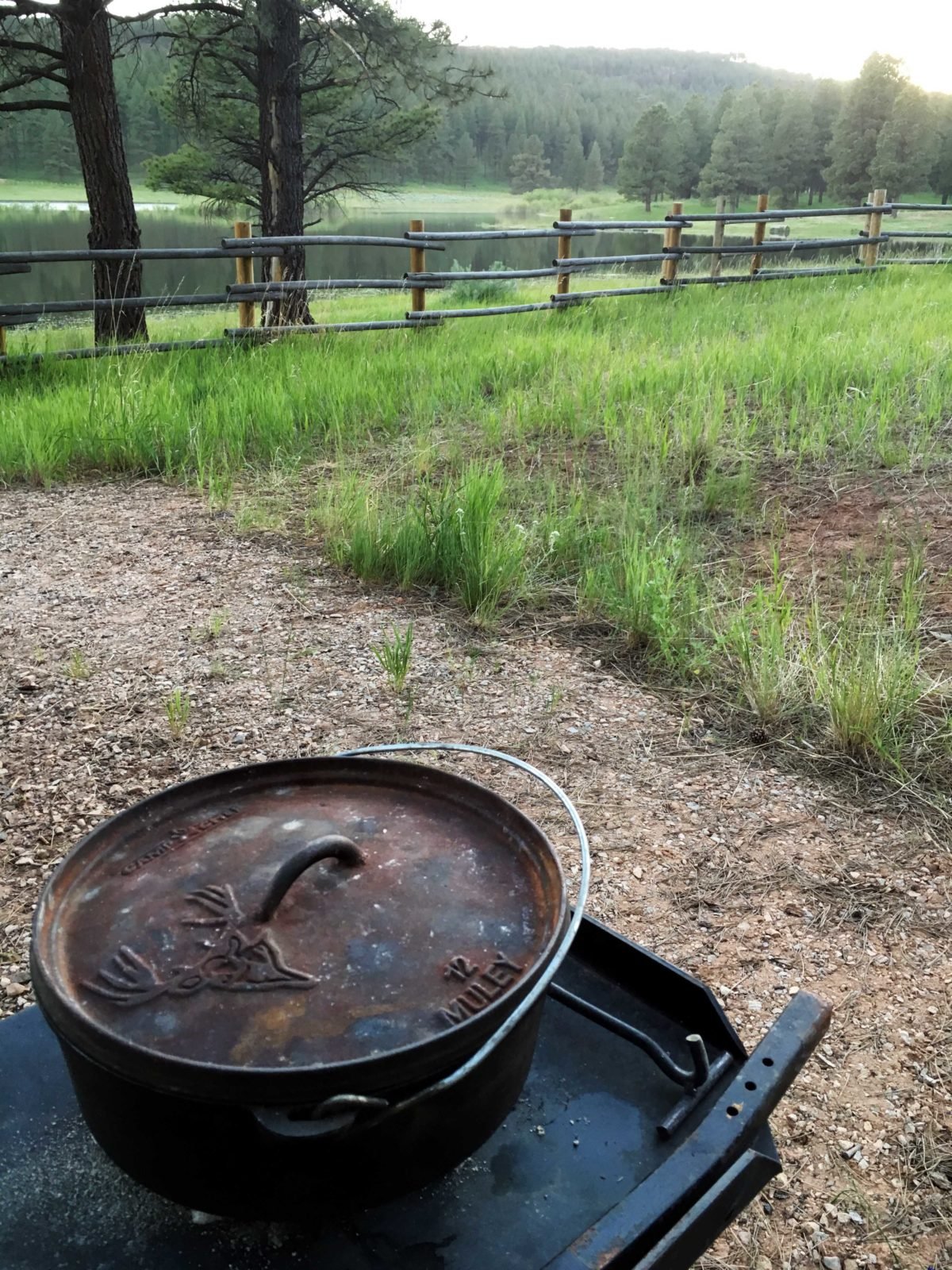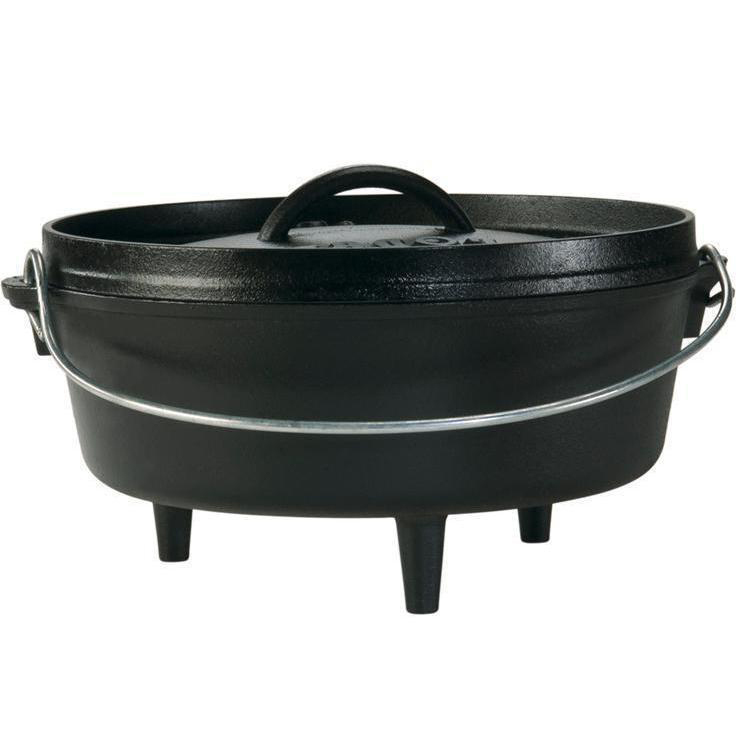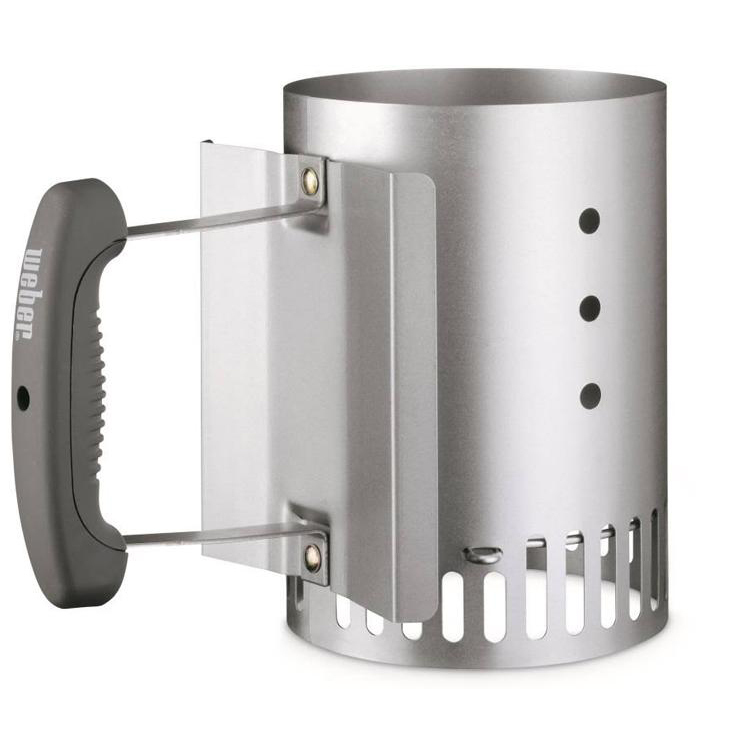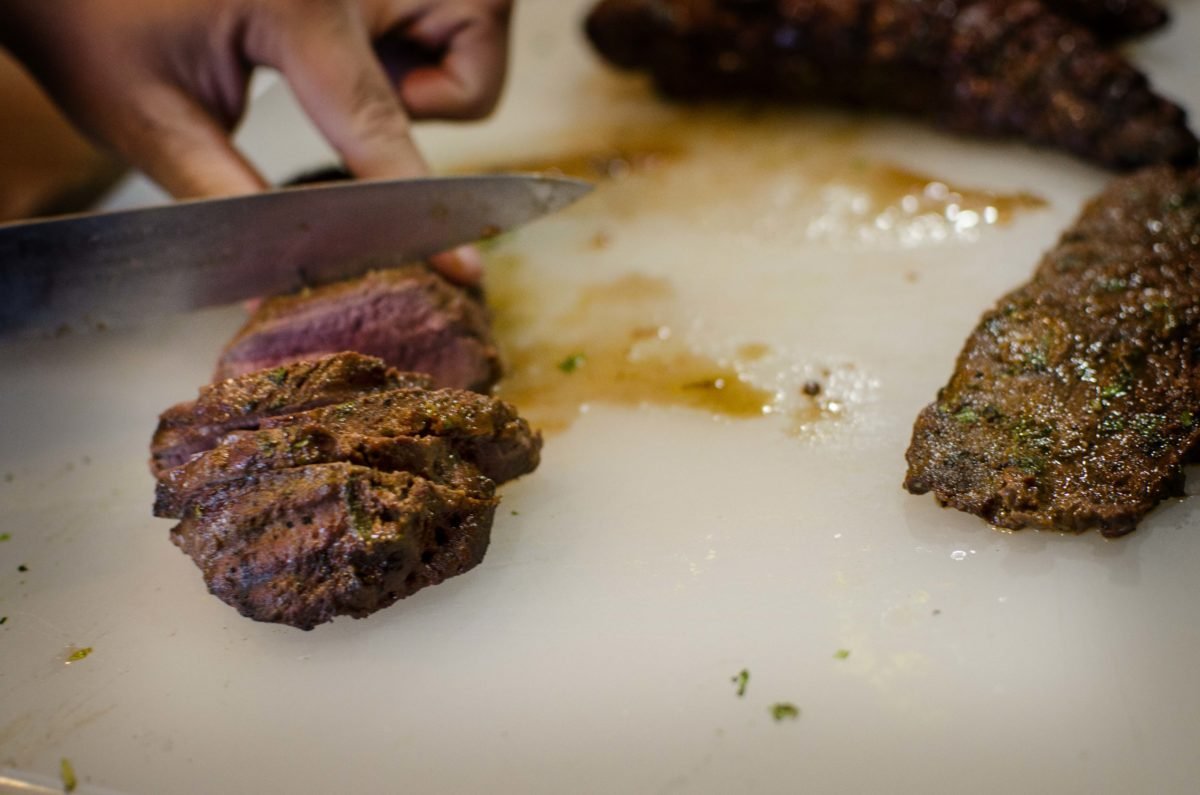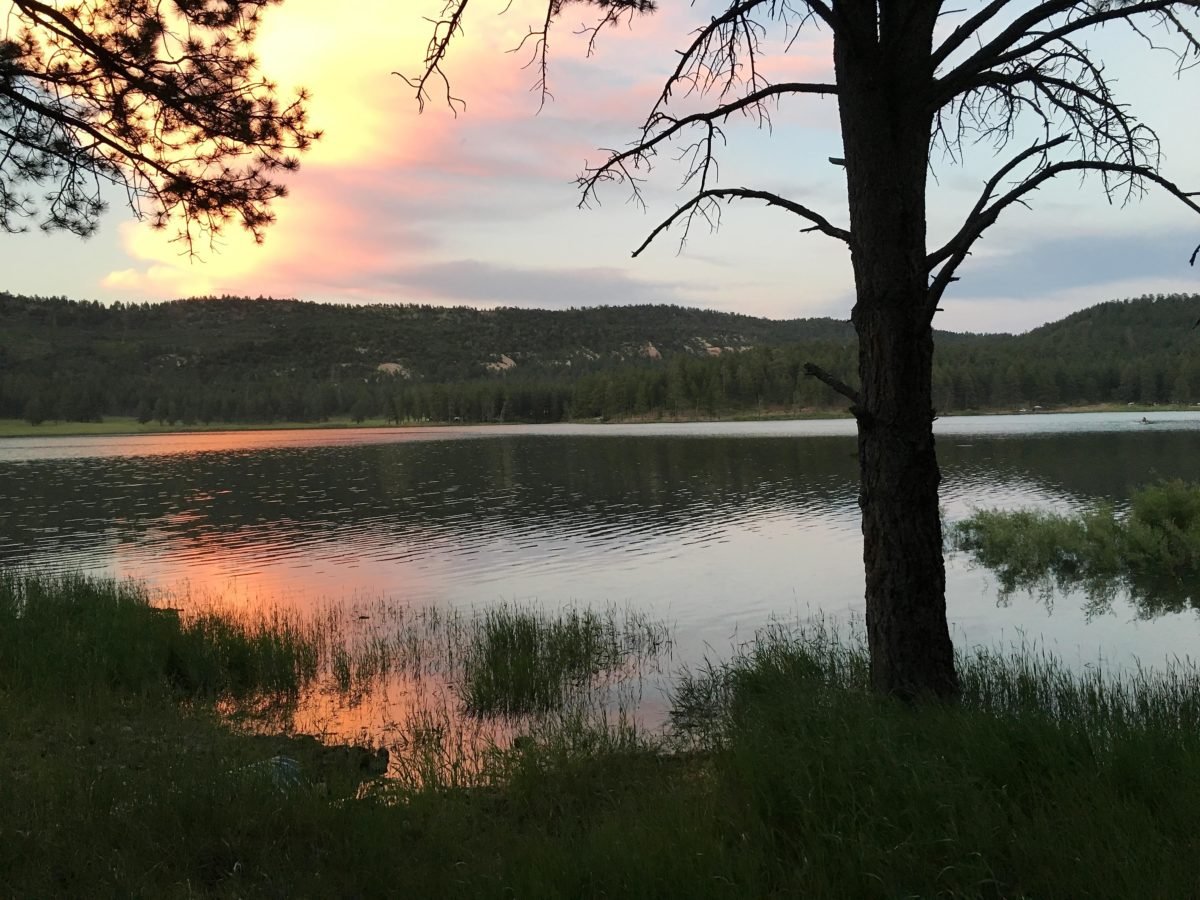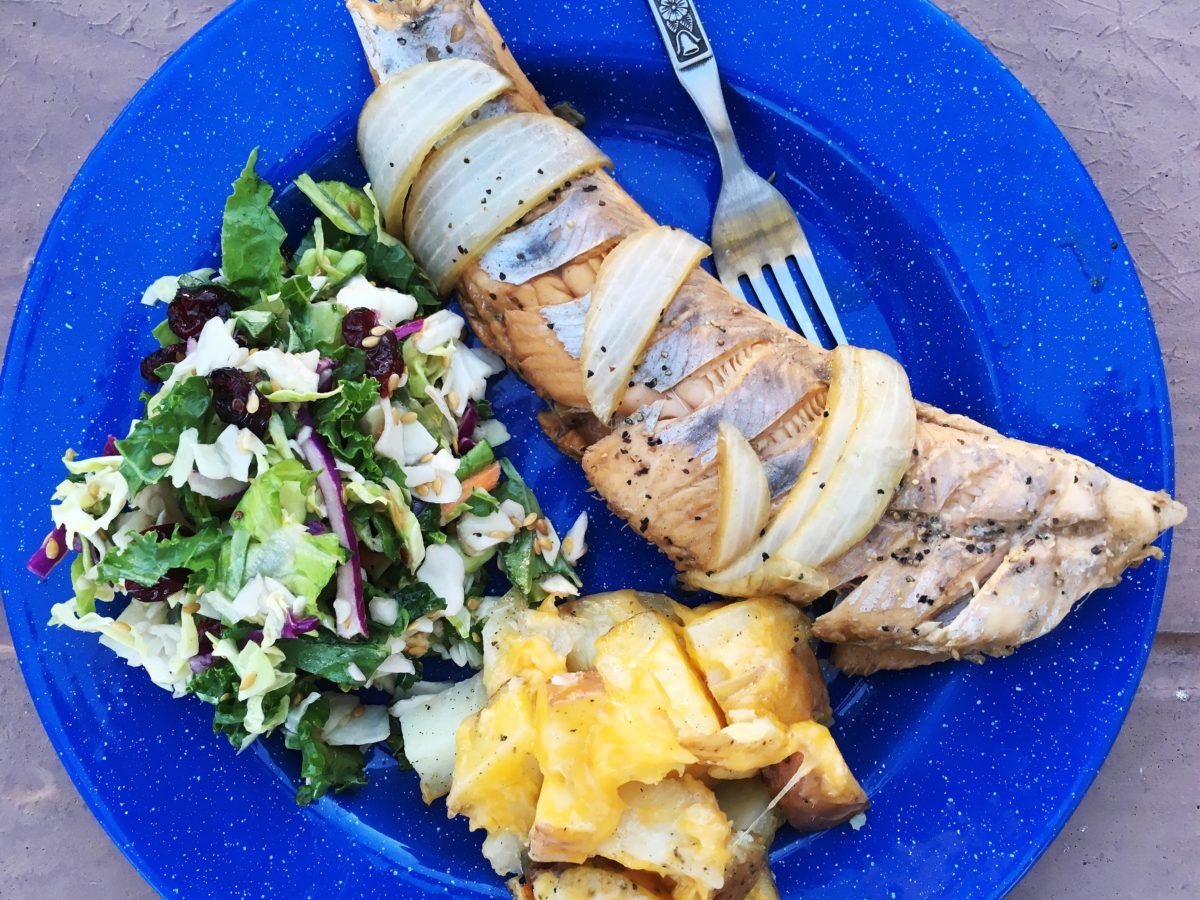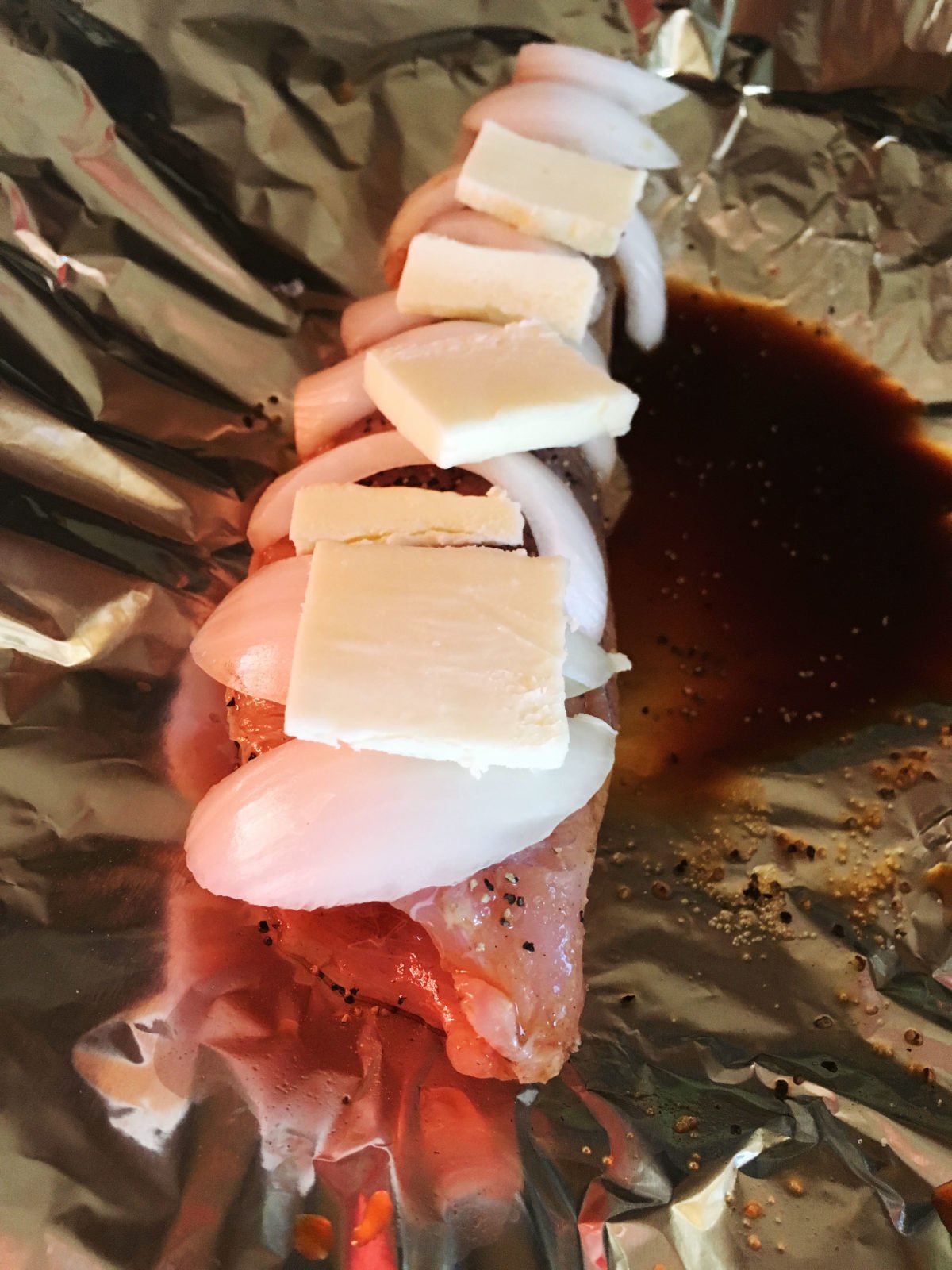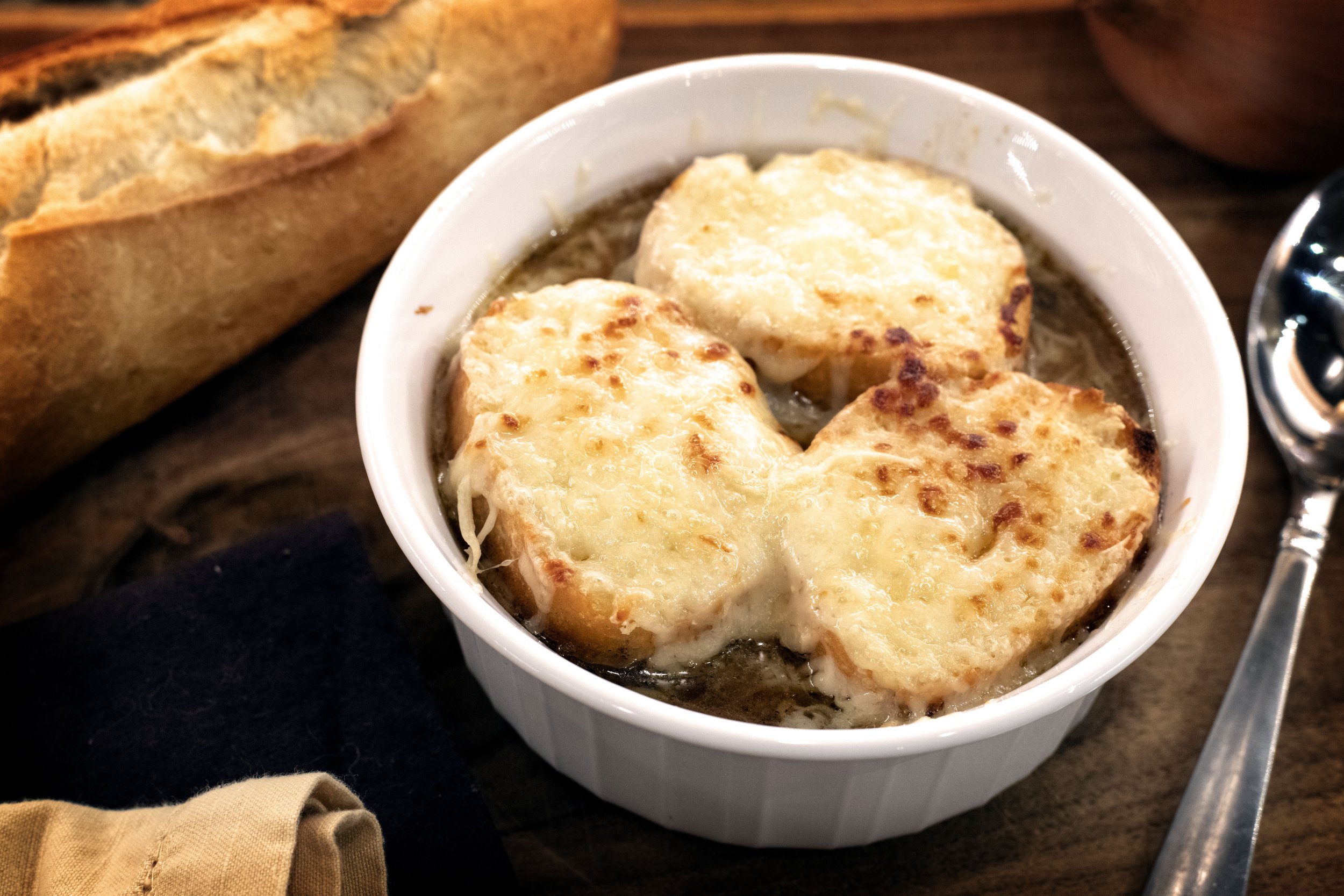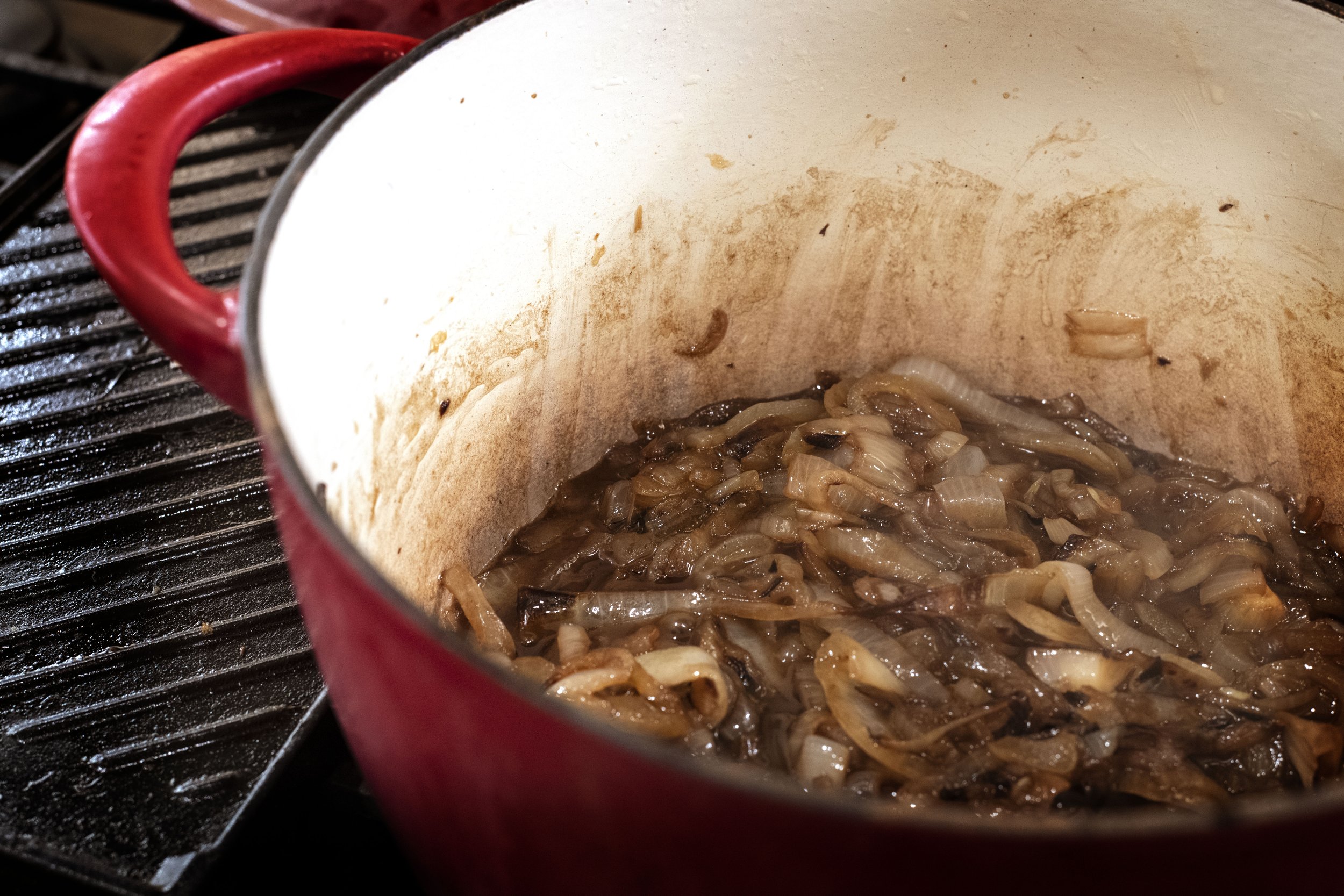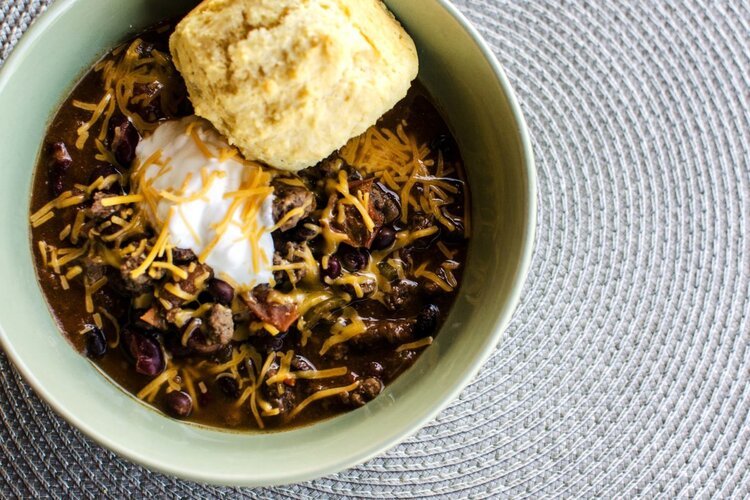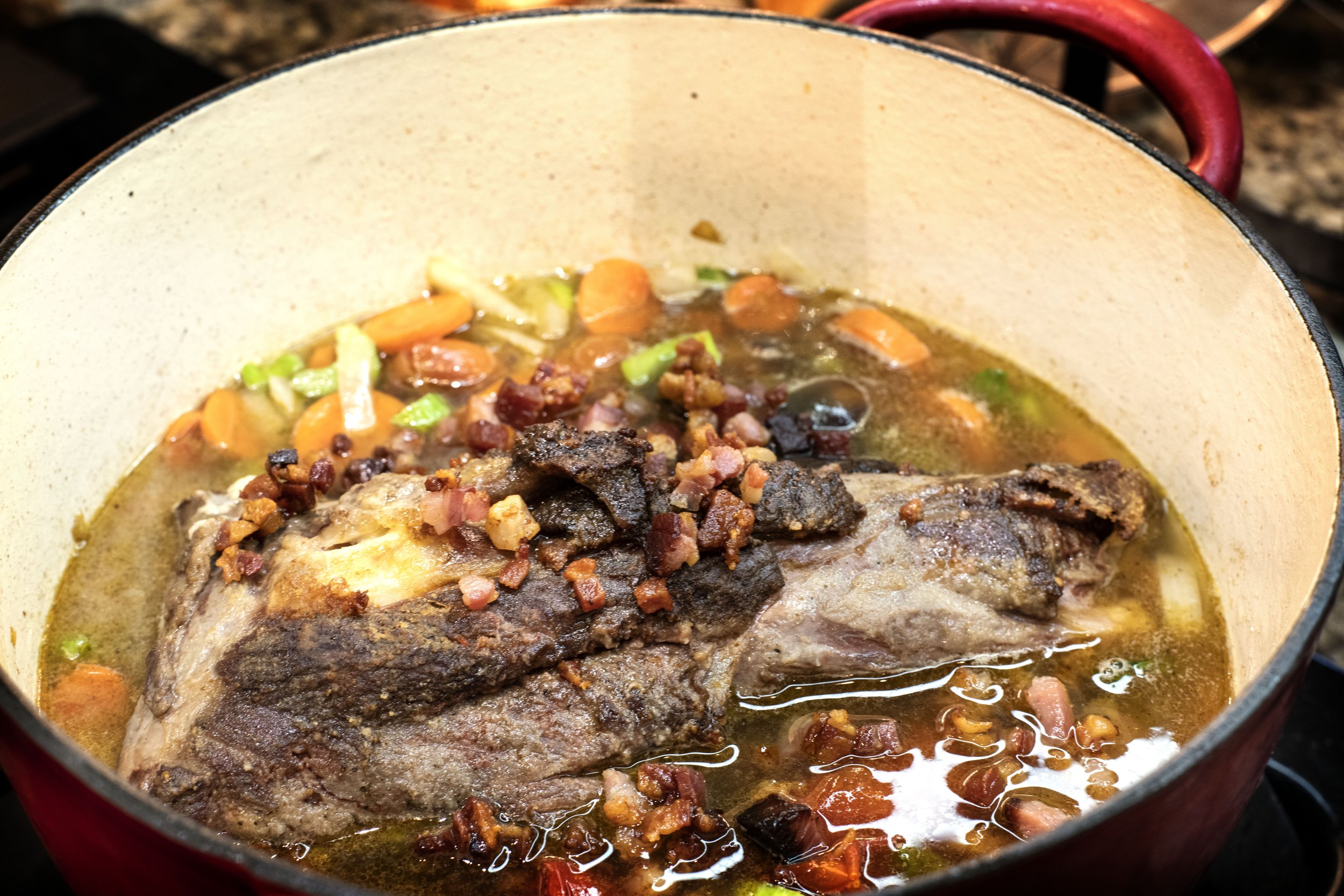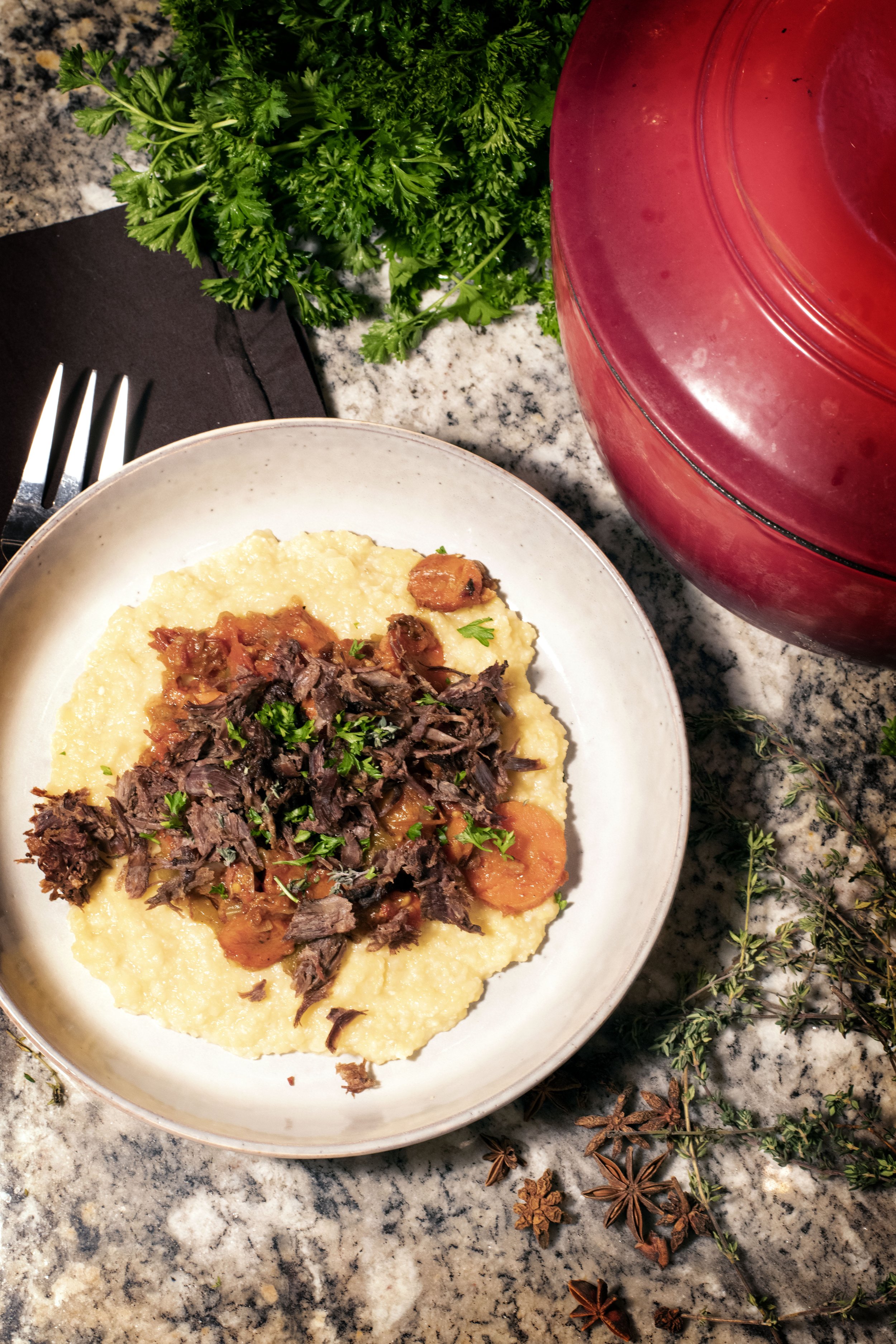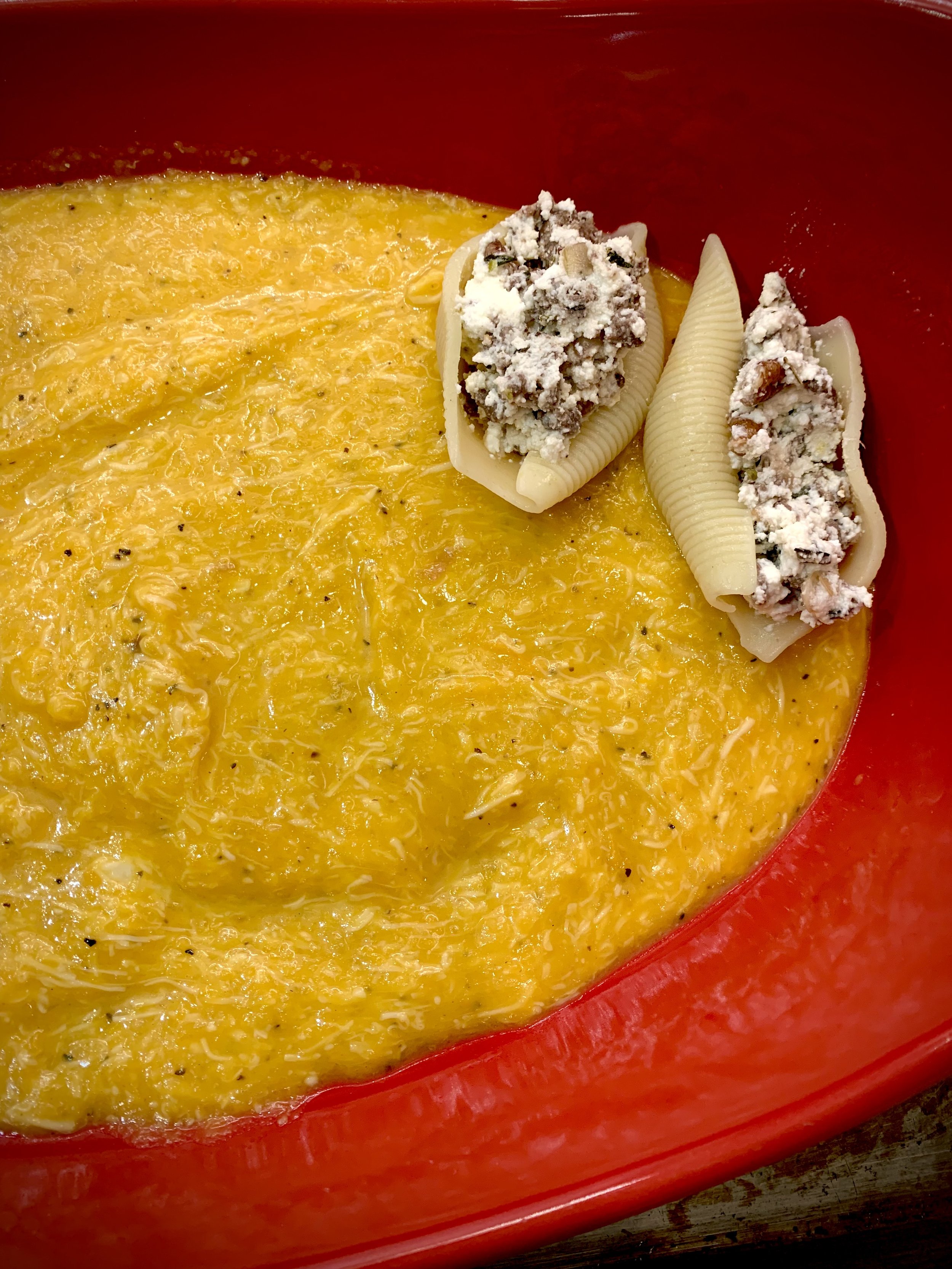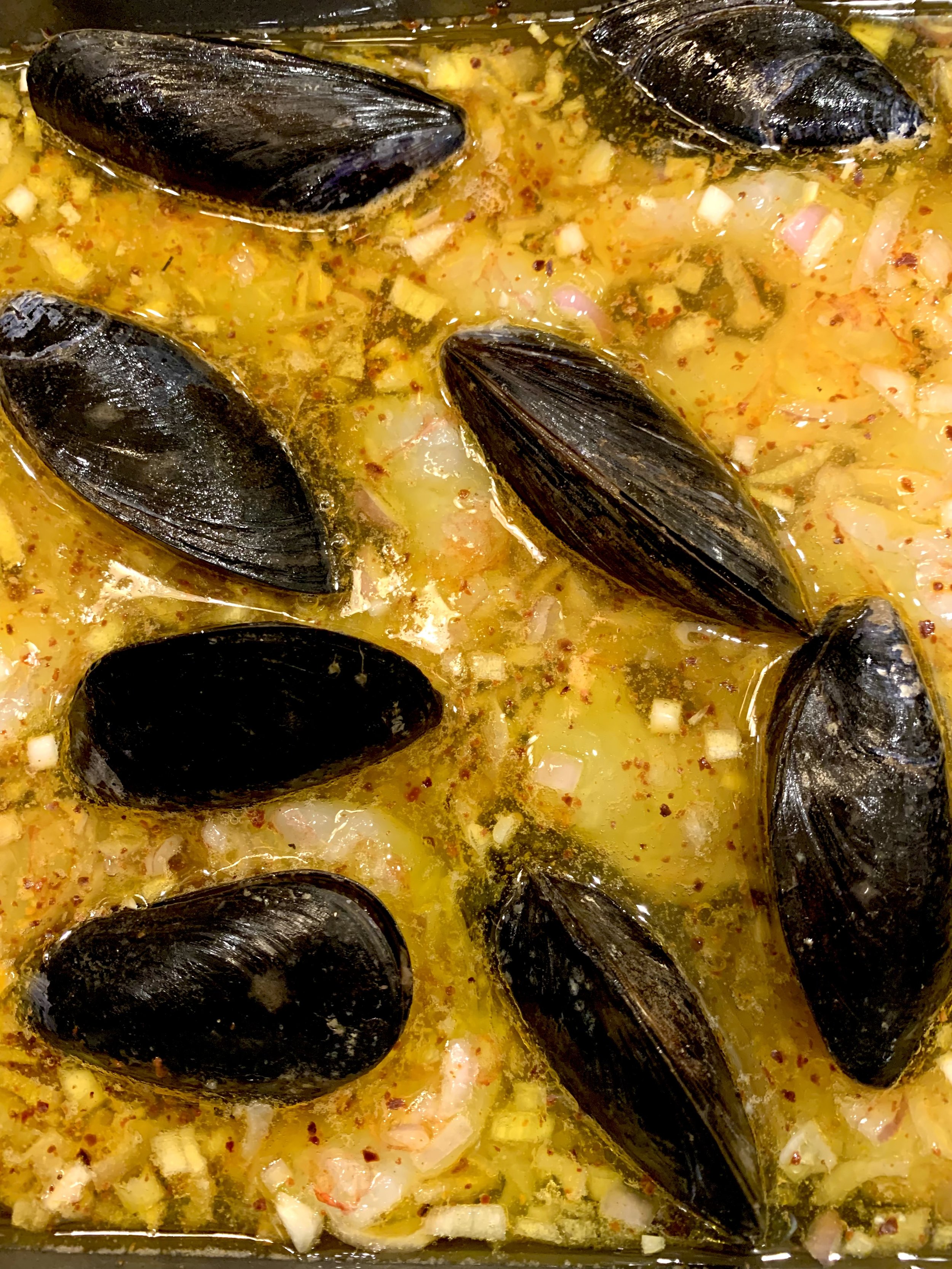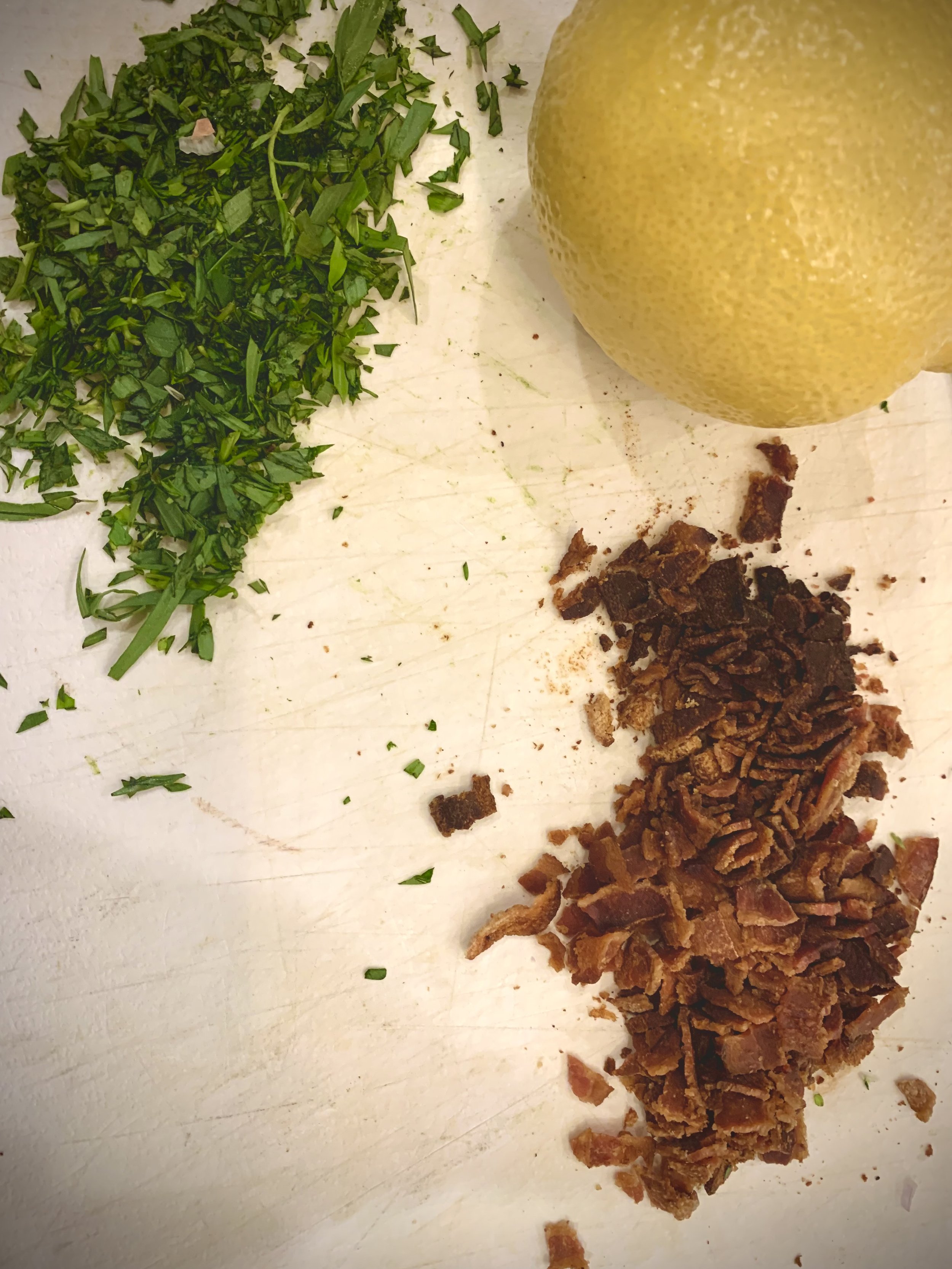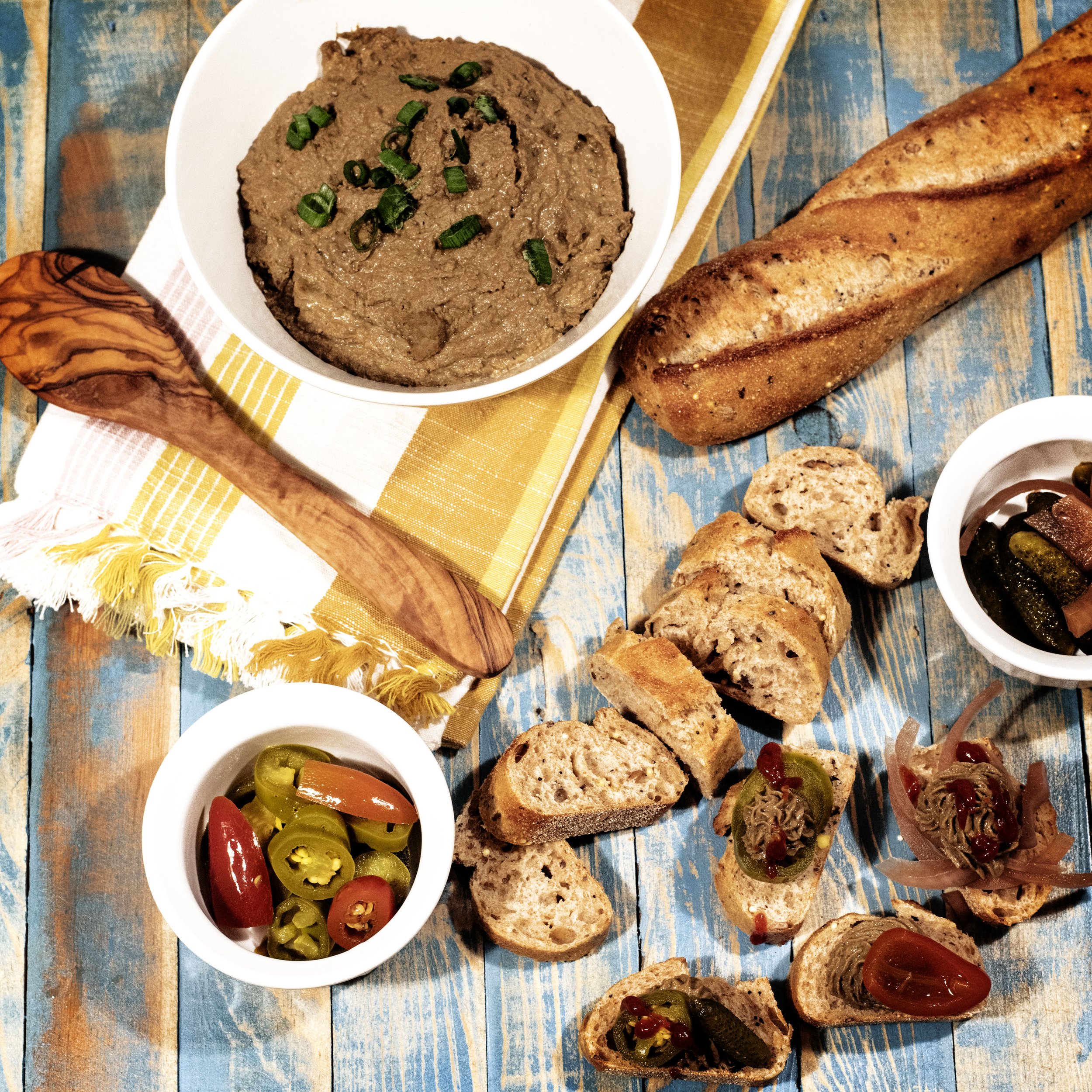Meaty pike skewers are marinated in zesty lemon and aromatic fresh rosemary, resulting in a hearty and rustic grilled fish perfect for serving at the next family barbeque night.
Salmon Burgers and Fresh Cut Fries!
Apricot Bear Chili
Morel Mushroom and Asparagus Risotto
This Morel Mushroom and Asparagus Risotto was not just delicious to eat. It was also an adventure just to get the ingredients. I found these morel mushrooms on the North facing slope of a burn scar on my hometown mountain. The previous summer a fire had devastated much of the forest area. As many people do feel when natural disasters strike, the town felt helpless, afraid, filled with anger they were unable to direct, and at the end of it all just sadness.
Looking up at the charred, blackened shadow of where the forest trees once stood, I wasn’t interested in walking through the forest just to be reminded of the life that once filled the area. I wondered how long people would stay away.
A few weeks ago, I saw an Instagram post about morel mushrooms. These fungi emerge from the ground after their symbiotic partner, the tree, has died. After a fire, when nothing is left of a tree but the burnt base and naked branches, the morels sprout from the dark soils of the tree’s roots in order to reproduce. Burn scars are prime morel hunting country, and I had one right in my own backyard.
I had never hunted morel mushrooms before but looking online they seemed like a good starting point for fungi harvesting. Their distinctive look makes them the perfect beginner’s mushroom for hunting. More information on morel hunting can be found here: Morel Mushroom Hunting Tips.
Once I was walking around the burn, it took a while before I actually found any mushrooms. Like with the start of most hunting outings, I grew impatient and frustrated, thinking I was wasting my time, within the first five minutes. I always start there. But once the forest starts feeding you with its information and you block out the noise of your daily life, the purpose no longer becomes to find mushrooms. The purpose becomes to take in the moment around you: the slight smell of ash from the fire still filtering through the air, the rich, dark soil at your feet contrasted by emerging baby greens, the crows noisy discussing amongst each other somewhere in the distance, the wind meandering through the cracks of the burnt trees, and the taste of the light mountain breeze against your lips.
It also is that much better when you find morels!
I found about a pound of morels, which was the perfect amount for making this Morel Mushroom and Asparagus Risotto. Let’s get started cooking it!
Morel Mushroom and Asparagus Risotto
Risotto is a somewhat time-consuming meal, but I enjoy it. Like mushroom hunting, it is a time to unwind and just take a moment to yourself. It is not overly complicated to make, just requires a little patience and the engagement of your stirring muscles. To start, clean the morel mushrooms with water, removing all the dirt, and then slice into quarters.
In a small saucepan over low heat, warm a quart of vegetable stock. The stock should be kept at a simmer. You will use this for your risotto here in a bit.
In a large skillet or even a dutch oven, add two tablespoons of olive oil and a tablespoon of butter over medium heat. Once the butter has melted, add your morels and asparagus. I cut the asparagus into two- or three-inch pieces for this recipe. Saute the mushrooms and asparagus until just starting to turn tender, about five minutes. Remove from the skillet and set aside.
To the same skillet, add another two tablespoons of oil and one more tablespoon of butter. Add a medium size diced shallot and cook for two minutes. Pour in a cup of arborio rice and toast for another minute, stirring to keep it from browning too much. Add a few sprigs of fresh thyme. You can add the entire sprig and remove it after cooking, or just add the leaves. I just added the leaves.
Pour in a half cup of Marsala wine and let it simmer until completely evaporated. It is now time to start making the risotto! This part of the recipe takes between 12-17 minutes and is the relaxing part of the meal. Add between a quarter and half cup of the warm vegetable stock to the skillet. Ensure your heat is at a level where the liquid is just simmering and not boiling. You want the rice to slowly absorb the liquid and if the heat is too high the liquid will just burn off before the rice has a chance to work its magic.
Keep slowly stirring until the rice has absorbed all the liquid from the pan and then add another scoop full and keep stirring. Repeat this low and slow cooking method until the rice no longer is absorbing liquid. It should take the entire quart of vegetable stock. I have had times where I add another half cup of water to finish at the end, but not often. You will know the rice is finished when it is soft and chewy. There should also be a very light, starchy sauce surrounding the rice by the end. It shouldn’t be dried out like when you steam rice.
Once the rice is finished, add back in the morels and asparagus along with another tablespoon of butter for a little extra creaminess. Warm for another two to three minutes.
To plate up this delicious meal, add a heaping scoop of the Morel Mushroom and Asparagus Risotto to a bowl. Sprinkle fresh chopped parsley and some shaved Parmesan over top. Drizzle with a little olive oil or balsamic vinegar glaze if so desired. Season with some salt and fresh cracked pepper. And there you have it!
Happy (Mushroom) Hunting
Hello, World!
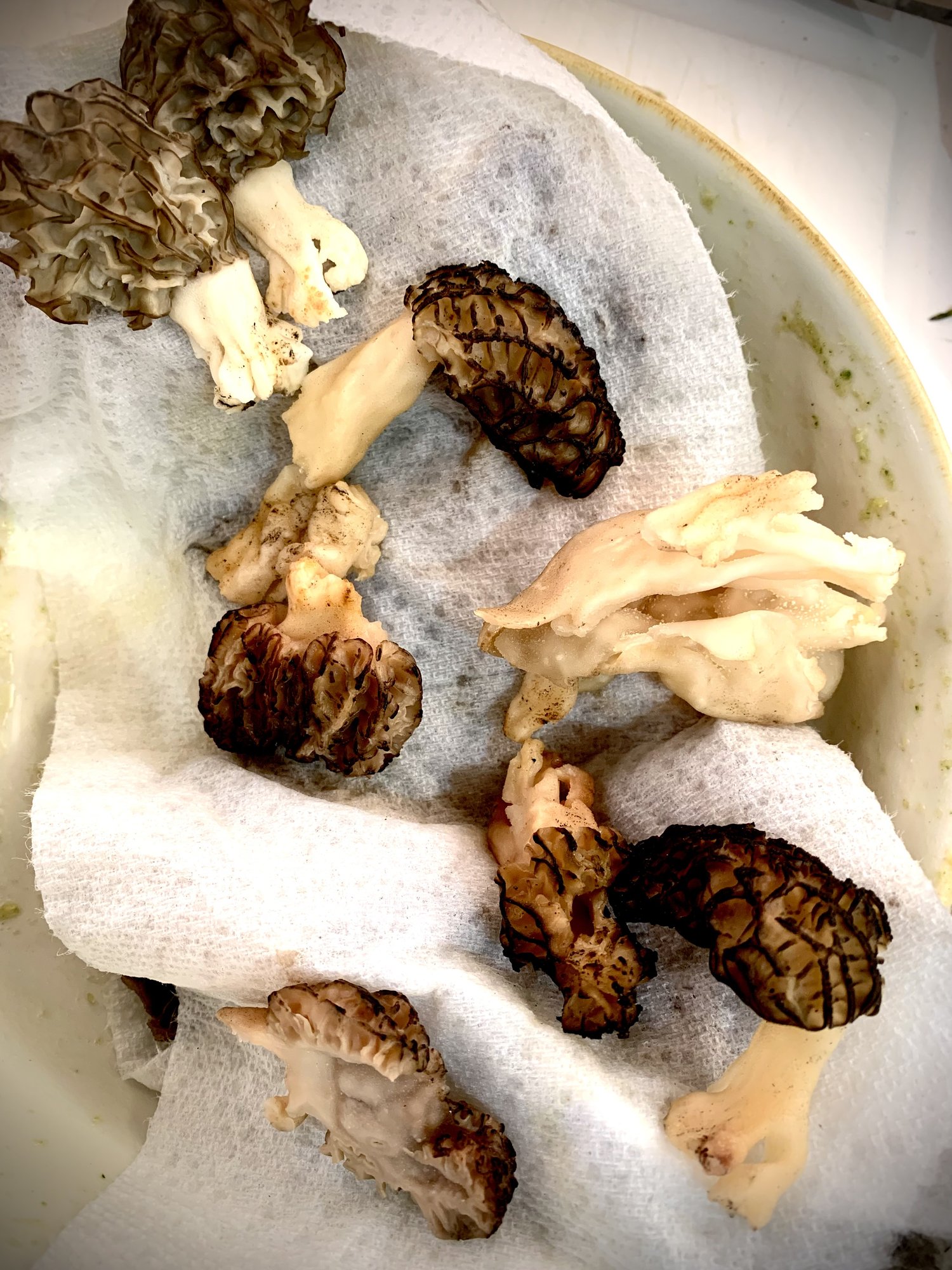
Morel Mushroom and Asparagus Risotto
Ingredients
- 1/2 pound fresh morel mushrooms, washed and quartered
- 1 pound asparagus, cut into 2 - 3 inch pieces
- 1 quart vegetable stock
- 1/4 cup olive oil
- 1/4 cup butter, cut into tablespoons
- 1 medium shallot, minced
- 1 cup arborio rice
- 1/2 cup Marsala wine
- 2 teaspoons fresh thyme
- Shaved Parmesan cheese
- Fresh parsley, chopped
- Salt and pepper to taste
- Optional garnishes: olive oil, balsamic vinegar glaze
Instructions
- In a small saucepan over low heat, warm a quart of vegetable stock This will be for building your risotto. Keep it warm while preparing the mushrooms and asparagus.
- In a large skillet or even a dutch oven, add two tablespoons of olive oil and a tablespoon of butter over medium heat. Once the butter has melted, add your morels and asparagus.
- Saute the mushrooms and asparagus until just starting to turn tender, about five minutes. Remove from the skillet and set aside.
- To the same skillet, add another two tablespoons of oil and one more tablespoon of butter. Add a medium size diced shallot and cook for two minutes.
- Pour in a cup of arborio rice and toast for another minute, stirring to keep it from browning too much. Add the fresh thyme leaves. Stir everything to coat in oil.
- Pour in a half cup of Marsala wine and let it simmer until completely evaporated.
- Add between a quarter and half cup of the warm vegetable stock to the skillet. Ensure your heat is at a level where the liquid is just simmering and not boiling. You want the rice to slowly absorb the liquid and if the heat is too high the liquid will just burn off before the rice has a chance to work its magic. Keep stirring often.
- Repeat this low and slow cooking method until the rice no longer is absorbing liquid. It should take the entire quart of vegetable stock. Sometimes additional water needs to added if the rice isn't quite soft and chewy after using all the vegetable stock.
- Once the rice is finished, add back in the morels and asparagus along with another tablespoon of butter for a little extra creaminess. Warm for another two to three minutes.
- To plate up this delicious meal, add a heaping scoop of the Morel Mushroom and Asparagus Risotto to a bowl. Sprinkle fresh chopped parsley and some shaved Parmesan over top. Drizzle with a little olive oil or balsamic vinegar glaze if so desired. Season with some salt and fresh cracked pepper
Smoked Trout and Pear Grilled Cheese Sandwiches
Did I really just suggest fish on grilled cheese? Yes I did! Now wait a moment before you leave this recipe and just hear me out. I too was hesitant and distrusting of this notion of fish on a grilled cheese sandwich. Fish and cheese has never been a pairing that comes to my mind, but this Smoked Trout and Pear Grilled Cheese Sandwich is amazing!
Every summer, I smoke large batches of any fish I didn’t prepare fresh after catching. The freezer bounty has ranged from rainbow trout to kokanee and salmon to albacore tuna. Smoked fish makes a great backing snack, presents beautifully on a charcuterie, and also pairs amazingly well with pears for a grilled cheese sandwich.
I first shared this recipe on Harvesting Nature and you can find the link for the recipe here: Harvesting Nature Smoked Trout and Pear Grilled Cheese. If you haven’t checked out this website, I suggest you head over there right now. The site has a large collection of wild game recipes, a podcast, and tons of articles about hunting and fishing. It’s a great site.
I am going to share some pictures and a recipe card for my Smoked Trout and Pear Grilled Cheese right here too (Just to keep things easy for ya)!
Happy Hunting!
Butter the sourdough bread and then top with a generous smear of mascarpone cheese. Top with some pear slices and plenty of fresh dill sprigs.
Next, add the smoked trout (or smoked fish of your choice) and then a add a thin layer of horseradish on top of the mascarpone cheese for the second slice of bread.
Grill the sandwich on medium high for three to four minutes per side.
And then dig in!!!!!

Smoked Trout and Pear Grilled Cheese Sandwich
Ingredients
- 10-12 large trout or fish of choice, can be left on bone but skin removed
- 1 cup salt
- 1/2 cup brown sugar
- 1 cup sugar
- 2 quarts water
- 1 can Old Bay Seafood seasoning
- 3 bay leaves
- 3-4 sprigs rosemary
- 1 bottle Cavit Pinot Grigio
- 2 pounds brown sugar
- Two filets smoked trout
- 8 slices sourdough bread
- 1 pear, thinly sliced
- fresh dill sprigs
- Prepared horseradish
- Mascarpone cheese
- Butter
Instructions
- You can leave the fish on the bone but should remove the head and skin.
- Mix the fish brine by filling a gallon freezer bag or large glass bowl with the water, salt, sugars, Old Bay Seasoning, bay leaves, and rosemary. Mix until the salt and sugars have dissolved.
- Submerge the fish completely in the brine and refrigerate for ten to twelve hours.
- Once finished brining, rinse the brine off the fish with cold water.
- Mix the bottle of Cavit Pinot Grigio, or other white wine of your choice, with the two pounds of brown sugar in a large pot. Bring to a gentle boil and stir until sugar has completely dissolved.
- Marinate fish in the wine and sugar mixture for one hour.
- Once the fish has marinated, place the filets on a drying rack and let dry until a glossy pellicle develops. I use a small fan to make the coating dry extra solid. Drying time varies, but it takes about an hour.
- Set the smoker to 180 degrees Fahrenheit. Fish should smoke somewhere between 165 and 225 degrees. If you go on the higher end, you tend to cook the fish instead of slow smoke, so I try to keep the temperatures lower. I also put aluminum foil on the grate below my rack to keep the fish from burning.
- For pellets, I used hickory, but there is a large variety of woods available. Fish tend to be paired with woods the produce a lighter smoke, including alder, maple, pecan, and apple.
- Smoke fish between 8 to 10 hours. The time depends on the thickness of your fish, so around hour six I start checking the filets with a meat thermometer. The fish is ready when it has reached an internal temperature of 145 degrees Fahrenheit.
- Preheat a skillet or cast iron pan over medium high heat.
- Spread a thin layer of butter on one side of each slice of bread.
- Generously slather each slice of bread with the mascarpone bread.
- Start stacking the sandwich! To one side of bread for each sandwich add a single layer of thinly sliced pears.
- Tear apart the smoked fish in bite size chunks and add to the top of the sliced pears.
- Add a healthy number of fresh dill sprigs.
- Finally, spread a thin layer of horseradish on the leftover slice of bread and then top the sandwich.
- Grill in the skillet for three to four minutes per side, or until the bread is golden brown and slightly crunchy.
- Enjoy!
Speckled Trout Scampi
You never know what you are going to have on the other end of your pole when Texas bay fishing. Growing up in the Rocky Mountains, I am accustomed to catching a small handful of various fish. Typically there are rainbow or brown trout. Sometimes you find a lake someone got a wild hair while stocking and added arctic graylings. For the most part, you are certain that when the tip of your pole makes that arching dip towards the water you know what is on the other end. Not true in salt water fishing.
During my week of fishing the bays of the Gulf of Mexico in Texas I pulled up fish I had never even heard of before. Just off a pier in the shallow bays near Corpus Christi with nothing but mullets for bait, which also were foreign to me before this trip, I pulled up sheepshead, speckled trout, lady fish, croakers, gafftops, and even a sting ray. Obviously not everything is suitable for the dinner plate, but that doesn’t affect the fun had when reeling in the line, wondering what could possibly be emerging from the salty waves.
What is suitable for the dinner plate is an entirely other adventure. I created a rice dish with a groundberry and macadamia topping from the sheepshead I caught in the first few days of the trip, and for this post I am using the speckled trout I caught a few days later.
Speckled trout, or also known as spotted seatrout, are a slender bodied fish with distinguishing black spots dotting their dark grey or greenish body. They also have two very funny looking teeth. They kind of look like a vampire that went to the dentist and had all their teeth removed except the two sharp ones.
Speckled trout meat is much softer than other fish, and especially more so than freshwater fish. It is a mild flavored, white meat that is moderately flakey. I don’t want to call it a mushy fish, as that tends to be a negative term when describing meat, but it is most definitely not a firm meat that holds together in flakes when you pull it apart. It has more of the texture of a lobster tail.
Due to the tendency of developing a “mushiness,” the fish does not hold up well to being overcooked. This ruled out grilling or pan frying in my mind, as those methods can lead to easy overcooking and I wanted this fish to turn out good so badly. So, with the texture in mind, I decided to do a Speckled Trout Scampi.
Speckled Trout Scampi
For this Speckled Trout Scampi you need a lot of butter. Think Julie Child’s level of butter. Two whole sticks, or a full cup, of unsalted butter. I know, it’s a lot. This definitely isn’t a heart healthy or waist friendly meal, but it is such a fantastic use of the spotted seatrout that you should treat yourself with all that butter if you happen to be lucky enough to catch such a fish.
You want to take filets from the speckled trout, removing them from the bone and also taking off the skin. Check the filets for bones in the meat, and also remove anything that is just, I don’t know a better way to put it, yucky looking.
Set the filets in a baking dish and preheat the oven to 350 degrees.
Meanwhile, in a medium size sauce pan, add the two sticks of butter and start to melt over a medium heat. Add the chopped five cloves of garlic, a half cup of chopped scallions, the fresh chopped oregano, some dried dill, and a half teaspoon of salt. Let everything simmer lightly for a few minutes.
Remove the pot from the heat and add in a half cup of dry white wine. If you aren’t a wine person, you could also add a quarter cup of lemon juice or a few tablespoons of apple cider vinegar. You just want something to put a little acid in the sauce.
Pour the butter mixture over the fish in the baking dish and place in the oven for 15 minutes.
As mentioned before, you don’t want to over cook the fish. I checked the first at about 12 minutes to make sure things weren’t getting too mushy. At 15 minutes the fish still held together but was just starting easily pull apart with a fork.
Serve the Speckled Trout Scampi over angel hair pasta. To plate, add a pile of noodles, place a fish filet on the bed of the noodles, and then drizzle a healthy pour of the butter sauce over the fish and noodles. Sprinkle with fresh minced parsley and fresh cracked pepper.
Enjoy!
Happy Fishing!
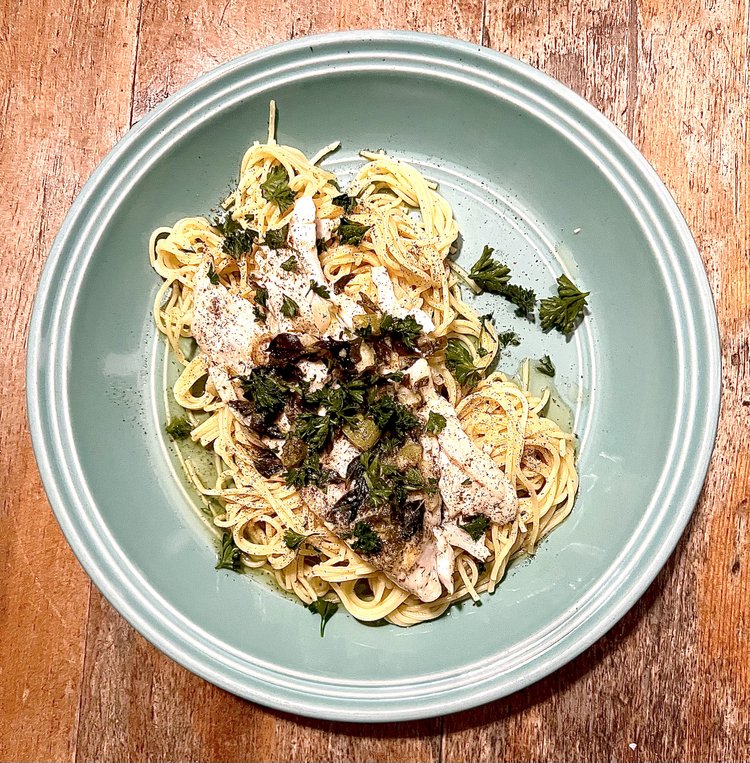
Speckled Trout Scampi
Ingredients
- 2 speckled sea trout, four filets total
- 1 cup unsalted butter - 2 sticks
- 5 cloves garlic, chopped
- Several sprigs fresh oregano, minced
- 1 teaspoon dried dill or 1 tablespoon fresh dill
- 1 tablespoon fresh parsley
- 1/2 cup dry white wine
- Salt and Pepper
- Pound angel hair pasta, cooked al dente
Instructions
- Preheat oven to 350 degrees Fahrenheit
- In a medium size sauce pan, melt the two sticks of butter.
- Add the chopped garlic, oregano, and dill. Cook for three to four minutes.
- Season with salt and pepper.
- Remove butter mixture from heat and add white wine.
- Place fish filets in a 9 x 13" baking dish. Pour the butter mixture over the fish filets.
- Place baking dish in oven and cook for 15 minutes.
- To serve, place pasta on plate and top with one fish filet. Pour a generous serving of butter sauce over fish and pasta. Sprinkle with fresh minced parsley.
Sheepshead Fish Rice Dish with a Groundberry Macadamia Nut Topping
Sheepshead. So, what is it? I had the same question when I pulled this Jurassic looking fish with its zebra striped body and sharp bladed spines from the bottoms of a Bayside, Texas ocean flat. It was about the size of a large dinner plate with large eyes and almost human like teeth. “That’s a sheepshead,” the man fishing next to me said. “They are good eatin’!”
My interest beyond the oddities of the fish’s appearance extended to how I was going to prepare this fish. Since it was my first time encountering this fish, I had to research what the guy meant by “good eatin’!”
Sheepshead fish are common in the shallow waters of the Atlantic and the Gulf of Mexico. The rows of stubby flat teeth are used for crushing its prey, which include oysters and clams. The meat is described as firm, moist, and oily. Sounds like the perfect protein to me! Let’s get started on this Sheepshead Rice Dish with a Groundberry Macadamia Topping.
Grilling the Sheepshead
I decided to grill the fish. I simply filleted this fish by taking a long, flexible, sharp knife and running it the length of the fish to remove the filet. I started a cut right above the eye and against the backbone and then cut down around the front fin to the belly. I used this cut to then pull the knife back all the way to the tail, removing a beautiful and thick filet.
The only bones you need to remove are the pin, or Y bones, from the meat. This is easy to do with a pair of needle nose pliers.
For a better description on how to clean the sheepshead, check out this website: Hunting and Fishing Depot.
Since I was grilling outdoors and grills are notoriously dirty, well not dirty but they aren’t clean like a skillet, I left the skin on the fish. I did not even bother to remove the scales for this particular fish since I was grilling it. The skin added protection to the filets from becoming burnt on the underside.
Once the grill was nice and hot I simply seasoned the sheepshead with salt and pepper, added a little dash of oil, and let them grill for 8-10 minutes, depending on the thickness of the filets. I knew they were finished when the meat was a opal white color and the edges are starting to develop that beautiful golden grilled coloring. Another test for this fish is to cook until you can easily slide a butterknife through the meat without resistance. The meat should be firm but falling apart.
Preparing the Groundberry Macadamia Nut Topping
In a medium bowl mix together the ingredients for the topping. I chopped the macadamia nuts and groundberries into bite size pieces for the topping, but you can leave them whole if you are so inclined. I added unsweetened coconut for added texture and body in the topping, and then a little coconut milk to hold everything together. The mixture should be the consistency of oatmeal and not too runny.
Season the topping with a little salt and some coriander.
I used groundberries to add a little sweet to this dish. Groundberries are small orange fruits originating from South America and are a member of the nightshade family. They are known by a variety of names in different parts of the world, including ground cherry, poha, aguaymanto, and pichuberry.
With a texture similar to the cherry tomato, groundberries are slightly sweet but also tart. They are popular in salsas and chutneys or over salads. They are also commonly added to desserts for not only their taste but also the aesthetic value they add to a dish.
Goundberries were perfect for topping this hearty sheepshead grilled fish with. The coconut, macadamia nuts, and groundberries give the dish a flair reminiscent of many Hawaiian dishes that are topped with pineapple. So, if you can’t find groudberries for the topping you could always substitute with pineapple, mango, or papaya.
To plate, add a large scoop of wild rice to the plate and nestle the grilled sheepsheads filet on top. I decided to remove the skin for actual plating because it is somewhat fishy and I didn’t want to add that flavor to my rice. Then, top with a heaping spoonful of the groundberry macadamia topping. Sprinkle with a little fresh chopped parsley and enjoy!
Happy Fishing!
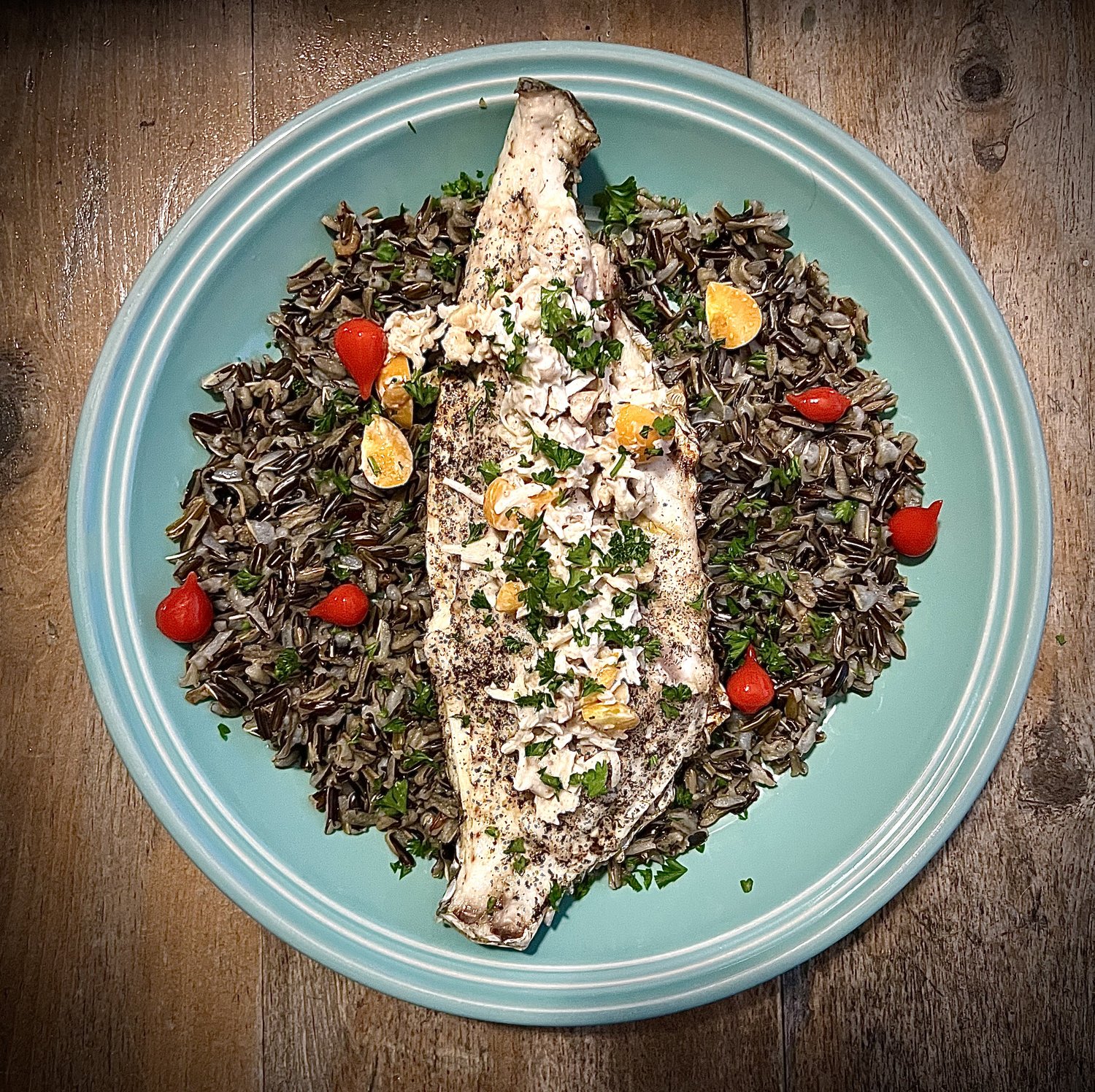
Sheepshead Fish with Groundberry and Macadamia Nut Topping
Ingredients
- 1 Sheepshead Fish - Filleted with skin left on
- 1/4 cup olive oil
- 1/2 to 1 cup coconut milk
- 1 pint groundberries
- 1 cup macadamia nuts, chopped
- 1 cup shredded, unsweetened coconut
- 1 teaspoon coriander
- salt and pepper
- Wild rice, prepared to instructions on box
Instructions
- Preheat the grill to high heat.
- Season sheepshead filets with the olive oil, salt and pepper
- With the skin on, place fish directly on grill, skin side down, and grill for 8-10 minutes or until the fish is white and firm. You can test the fish to see if it is done by pressing a butterknife into the meat. It should easily slide through the meat without much resistance.
- For the topping, in a medium size bow mix together the shredded coconut, chopping groundberries, and macadamia nuts.
- Add coconut milk slowly until the consistency holds together but is not too runny.
- Season to taste with salt, pepper, and coriander.
- Serve fish over a bed of wild rice and top with the groundberry macadamia nut topping.
Dutch Oven Baked Pears and Cherries
When camping, dessert typically consists of such campfire classics as s'mores, fruit cobblers, and caramelized bananas or peaches. Don't get me wrong, these traditional camping delights are one of the main reasons I enjoy spending a night under the stars. I can't deny the nostalgia I get when roasting a marshmallow on the end of a long stick I spent an hour searching for through the dark, stumbling and tripping over fallen tree branches. Childhood quickly returns as one crunches into a gooey, chocolate and marshmallow graham cracker s'more. It is awesome.
However, since purchasing a dutch oven, I have discovered dessert can be more than something concocted over the flames of a fire on the end of a stick. Dessert can be something you find in a five-star restaurant, such as this baked pear with dried cherries.
While this dessert is decadently eye-catching, and smells sweet and rich, it is incredibly simple to put together. It requires very few ingredients, minimal prep time, and cooks quickly.
For this dessert, gather together a pear per person. For this time, I did three pears, but a 14 inch oven, like the one I used, will hold up to six. Some dutch oven recipes require a specific oven size in order to create a perfect cooking environment. One of the beauties of this dessert is it can be prepared in any size oven.
Other necessary ingredients include a bottle of your favorite semi-sweet white wine. I used a pinot grigio, but others such as a moscato or zinfandel would work great. Another option would be a semi-sweet red wine. A pinot noir would work nice or maybe a red zinfandel. Also needed for the recipe is some honey, ground cinnamon, nuts, and dried fruit. I used walnuts and dried cherries this time, but other great alternatives could include almonds or pecans for the nuts and currants or cranberries for the dried fruit. As you can see, it is a very flexible and diverse recipe.
Before prepping the pears for cooking, start the cooking coals. The coals are easiest to start in a charcoal chimney. To do this, crumple up some newspaper and place it below the chimney, pour the desired amount of coals into the chimney, for this recipe you will need around thirty, and light the paper. Allow the coals to cook until the ones at the top of the chimney are just starting to turn grey. This can take awhile, so you want to start the coals a good time in advance, such as twenty minutes.
When making desserts, I like to line the inside of the dutch oven with aluminum foil. This helps to keep the pears from sticking to the bottom of the oven, and also makes clean-up easy.
To prepare the pears, begin by removing the peels. Cut the stem off from the top of the fruit, and then remove two thin slices from each side of the pear. Removing the thin slices creates a stable base for the pear to sit in the oven. Finally, cut the pears in half. Use a spoon to scoop out the seeds and coarse center for the fruit, which also creates a nice bed for the honey and cinnamon to settle into.
Lay the pear halves into the oven and drizzle them with honey. Sprinkle each pear with your desired amount of cinnamon. Drop in the dried cherries and nuts. It is okay if some of the ingredients end up in the bottom of the oven instead of on top of the pears, they will just cook down into the wine and create a syrup.
At this point, it is easiest to carry the oven over to the coals. Set the oven on top of about 10 to 12 coals. Slowly pour in your wine, being careful to not splash it over the pears. The amount of wine needed will depend on the size of your oven. I just kept pouring until there was about a half an inch of wine in the bottom of the oven. Cover the oven and place about ten coals on the top of the oven. Allow the pears to cook for twenty to thirty minutes, or until they are soft.
The sweet aromas of the pears and dried cherries may seem like this dessert is already enough, but it doesn't stop here! Plate up two halves of pear per person, making sure each serving is covered with a generous portion of cherries and walnuts. Drizzle the sticky, thin syrup from the bottom of the pan over each pear, and top everything off with a dollop of whipped cream. The warm pears and sticky honey will melt in your mouth, and everything is topped off with the sweet, cool taste of the whipped cream and a slight crunch from the walnuts! This dessert will make you simply sigh.
So, enjoy this decadent fruit dessert, but fear not, s'mores are still on the menu for all camping excursions.
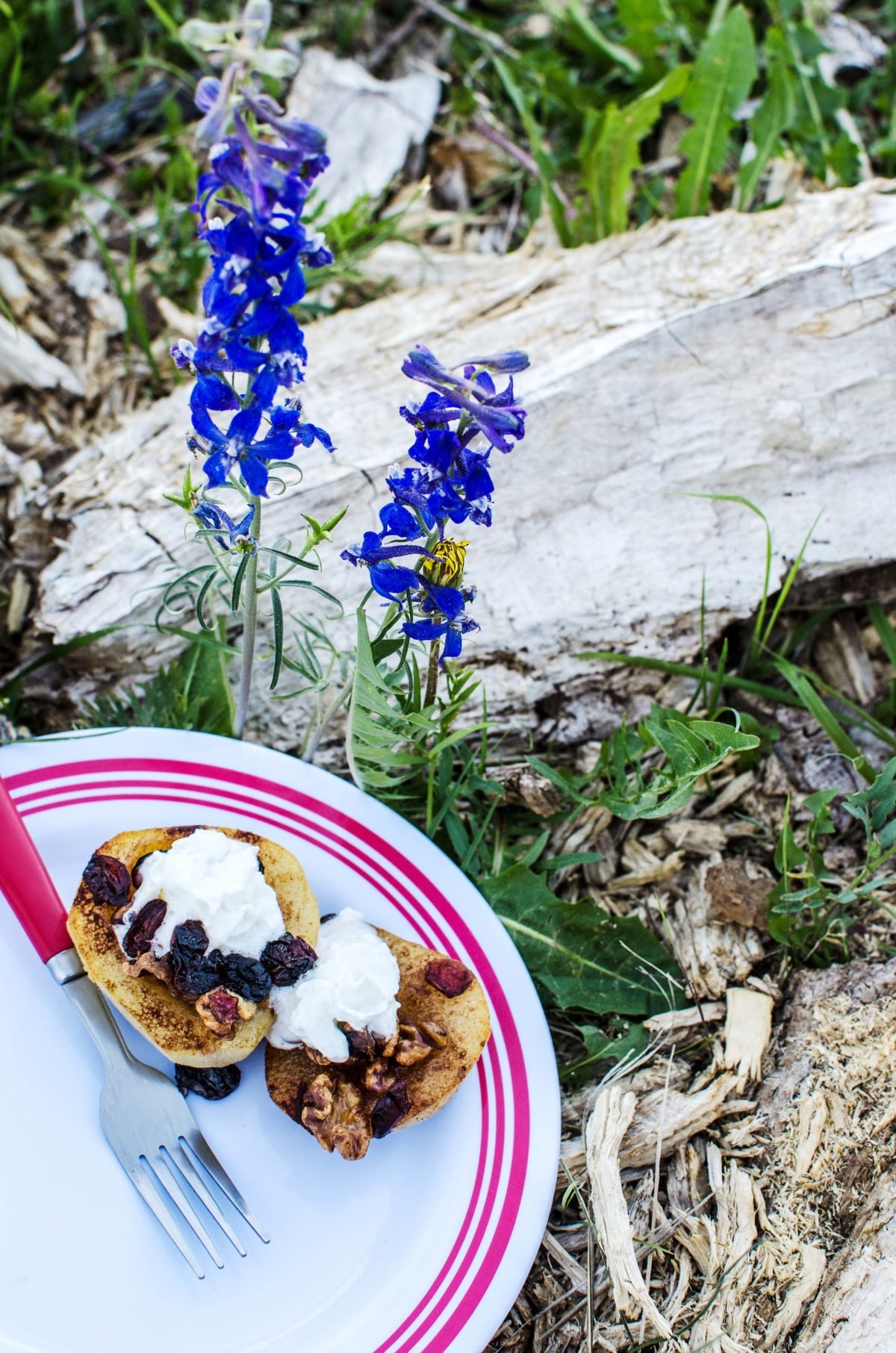
Dutch Oven Baked Pears and Cherries
Ingredients
- Six bosc pears
- Three tablespoons honey
- One tablespoon cinnamon
- One cup dried cherries or other dried fruit of choice
- One cup of walnut or other nut of choice
- Bottle of semi-sweet wine, such as pinot grigio, moscato, or zinfandel
- Whipped cream for topping
Instructions
- Begin by preparing the coal briquettes in the charcoal chimney. Allow coals to cook for twenty to thirty minutes, until the top coals in the chimney start to turn grey.
- Line the oven with aluminum foil.
- Peel the skin from the pears, and cut the stem from the top.
- Take a small slice from two opposite sides of the pear, creating a flat bottom for the pear halves to sit on.
- Cut the pears in the half and scoop the seeds out.
- Lay the pear halves in the oven and drizzle with honey.
- Sprinkle on cinnamon.
- Drop in cherries and walnuts.
- Place the oven on top of 10 to 12 coals.
- Add the wine to oven, taking care to not splash it on the pears. Pour in until about a half inch of liquid is in the bottom of the oven.
- Cover and place 10 coals on the top of the oven.
- Bake for twenty to thirty minutes, or until the pears are soft.
- Top each portion with a healthy dollop of whipped cream!
Coffee Crusted Elk Steak
This coffee crusted elk backstrap steak is a meal to write home about. The steak is crusted in an acidic and rustic dry rub of coffee and mushrooms and then drizzled with a rich stout glaze. The shoestring onions add a crunchy balance against the juicy elk backstrap steak.
The recipe was originally featured on Harvesting Nature, and a link to that recipe can be found here: Harvesting Nature Coffee Crusted Steak.
I have included a recipe card here as well! Enjoy!

Coffee Crusted Elk Backstrap Steak
Ingredients
- 2 onions, thinly sliced
- 2 cups buttermilk
- 1 cup flour
- Tablespoon salt
- ½ Tablespoon cayenne
- Black pepper to taste
- 3 cups frying oil (vegetable, avocado, canola)
- 2 Tablespoons butter
- 1 medium shallot, minced
- 12oz stout beer
- 2 Tablespoons honey
- 1 Tablespoon molasses
- 1 Tablespoon Worcestershire sauce
- 4 elk backstrap steaks, about 2 inches thick each
- 2 ounces dried porcini mushrooms
- 2 ounces ground coffee
- 1 Tablespoon cocoa powder
- 1 Tablespoon cinnamon
- 1 Tablespoon salt
- 1 Tablespoon oregano
- 2 -3 Tablespoons fresh sage, minced
Instructions
- Start with preparing your fried onion shoestrings. Thinly slice the onions. If you can use a mandolin to get a fine slice that is easiest, but you can just cut thinly with a sharp knife.
- Be sure to pull the onion slices apart and submerge completely in buttermilk. Let sit for at least one hour.
- In a large ceramic Dutch oven or deep fryer, heat a couple cups of a high temperature frying oil, such as avocado, canola, or vegetable, to 375 degrees.
- In a shallow bowl, mix a cup of flour, tablespoon of salt, fresh cracked black pepper, and ½ tablespoon of cayenne.
- Shake the excess buttermilk from the onion strings and coat completely in flour mixture. Shake excess flour from onion strings and immediately add to hot oil. Work in small batches to keep the oil temperature from dropping.
- Fry the onion shoestrings for one to two minutes, until the onions are a golden brown. Keep the onions separated from each other for optimal crispiness.
- Remove onion batch from oil and place on paper-towels to drain some of the oil off. Repeat with rest of onions.
- In a medium saucepan over medium low heat, add two tablespoons of butter. Once the butter is melted add a finely diced medium sized shallot. Cook for five minutes, until the shallot is soft.
- Add a bottle of stout beer, two tablespoons of honey, a tablespoon of molasses, and a tablespoon of Worcestershire sauce. Allow the mixture to simmer and reduce the liquid down by half, which should take fifteen to twenty minutes.
- Cut your wild game backstrap into two-inch-thick steaks. Let the steaks sit out at room temperature for about thirty minutes before cooking.
- While the steaks are coming to room temperature, prepare the coffee coating. In a spice blender or coffee grinder, mince up the one ounce of dried porcini mushrooms.
- Add the ground porcini mushrooms to a bowl along with 2 ounces of ground coffee, one tablespoon of cocoa powder, 1 tablespoon of cinnamon, a tablespoon of salt, and the dried oregano. Mix everything together.
- Coat the wild game back strap steaks completely in the coffee and mushroom mixture.
- Heat a large cast iron pan over medium high heat. Once the pan is heated, about two minutes, add the steaks to the hot pan.
- For a medium rare steak, cook the steak for six to seven minutes per side to an internal temperature of 145 degrees Fahrenheit.
- Let the steaks rest for five minutes before serving. To plate, pile a heaping serving of fried onion shoestrings on top of the coffee and mushroom crusted steak. Drizzle with the stout sauce and top with minced fresh sage.
Dutch Oven Nachos
Dutch Oven Nachos have made me re-think campfire meals. I always struggled with dinner the first night of a hunting trip. Usually, we pull into camp after dark. Everyone knows how it goes. You have a long weekend planned full of camping, fishing, hunting, hiking, and recreating, but you can't leave until after work on Friday. And then when you get home from work, you realize you have to go grocery shopping for three days worth of food. And then you realize you have to load the truck. And the entire drive to camp you are remembering all the things you left at home, like a pillow or the coffee (Oh man! Don't even start with me on someone forgetting the coffee, talk about a camping nightmare!). When all is said and done, you pull into camp after dark, and you still have to set everything up!
"Life is a nacho. It can be yummy-crunchy or squishy-yucky. It just depends on how long it takes for you to start eating it." ~ John Updike
It is always at this point I realize dinner is going to be a midnight affair, if we are lucky. Usually I like to start my hunting trip with a memorable dinner to kick the weekend off right, but that plan always backfires, as it is too late to dutch oven anything in hopes it will be ready in a reasonable amount time for everyone to eat. We usually end up grumpily eating sandwiches, which were supposed to be for lunch the next day but have now replaced dinner. Everyone goes to bed a little disappointed at the start of the trip.
Well, this sad story will not be repeated for us anymore! I have found the PERFECT dutch oven meal for your first night at camp: Dutch Oven Nachos! They are quick, easy, delicious, and give that fun feel to the start of the weekend you are looking for, because hey, you are eating nachos in the outdoors and how fun is that? My favorite dutch oven meals are the ones that bring the unthinkable to the outdoor. Usually, nachos are made in the oven, or at least the microwave, and have a ton of ingredients so they don't really sound like a very easy camping meal. Don't be fooled, they are super easy!
The key to not having your nachos ready at midnight is to pull the charcoal chimney out when you first arrive at camp and light your briquettes. The briquettes will be ready to go by the time you are finished setting up the tent. Besides the coals, there is very little prep needed for this meal. Light the coals and allow them to heat until the top ones have just started to turn grey. I used to let them burn until the top ones were completely grey, but this resulted in the coals at the bottom of the chimney amounting to nothing more than dust.
The fun thing about nachos is you can top them with pretty much anything your heart desires. They can be filled with meat or vegetarian, spicy or mild, topped with a pile of veggies, have beans of several varieties, and so on. Anything the old heart desires!
I used a 12 inch Dutch oven for these nachos, but really any size will work. The temperature is not crucial to the success of this meal, like it would be if you were doing biscuits or some type of cake, so you can be flexible in the size of your oven. To start, I poured a very thin layer of nacho cheese sauce in the bottom of the oven. I felt that if I set my chips directly onto the bottom of the pan without a little bit of liquid they might burn. For those of you who might not know what nacho cheese sauce is, like I did not before making this meal, it is canned cheese found in the Hispanic food section of the grocery store. There were several varieties available out my grocery store, and I went with a queso fresco style, but you could get anything that catches your fancy. There were several varieties filled with different chilies or spices.
On top of the thin cheese layer, add a layer of chips. Everyone likes a different style of tortilla chip, and you can't change their mind once it is set. Trust me, I have experienced this with the loved ones in my life. No fight is ever as vicious as when someone pulls out a brand of tortilla chips that is different than my sister's or my dad's favorite brand. So, use whatever brand of tortilla chips you love, but my suggestion, and it is purely a suggestion, is the Mission Tortilla Rounds. I like to use these for nachos because they are a bit thicker than some of the other brands, which means they hold up a little better to the cheese or other ingredients that make nachos soggy.
To the tortillas, add a layer of shredded cheese. I used the Mexican cheese blend, but you could also use any variety of cheddar, Colby, or even Italian style cheese. Pepper jack cheese would add some nice spice and heat to your nachos. Next I poured half a can of black beans on top of the cheese. Again, there are several options of beans that could be added, including red kidney beans, pinto beans, or refried beans. At this point, you could also add meat. For this time around, I was looking to make a very quick meal and I did not add meat, but shredded chicken, pork, or steak would be amazing! You could also do chorizo or hot sausage. And that is something you could prepare at home and it would then be quick and easy to throw onto the nachos.
I added a couple more toppings to this pot of nachos, including pickled jalapenos, sliced black olives, and some diced tomatoes. You can create any flavor combination you want at this point. Other great toppings could include: diced pineapple slices, bell peppers of any color, red or white onion, zucchini (I know sounds, kind of weird but it is actually pretty good), shredded carrots, and whatever else you can dream up.
So, once you have all your toppings added, it is time for the second layer. Add another layer of tortilla chips, top with more cheese, the other half of the can of beans, and all the additional toppings you have decided to add. Top it with a final layer of chips and a sprinkling of whatever cheese is left over. To finish it off, pour the entire can of nacho cheese over the top of the nachos and let it run down through the mountain of chips and toppings you have created.
Place the lid on top of the oven and set over your hot coals. I did about ten coals on the bottom of the oven and added another eight coals to the top. Let the nachos cook for 15 to 20 minutes.
While the nachos are baking away, you can prepare the fresh toppings for your nachos. For this time around, I added shredded lettuce, salsa, diced avocado, and sour cream.
The nachos are ready once the cheese is all melted! Pile on your favorite toppings and enjoy around a crackling campfire!
Happy Hunting!
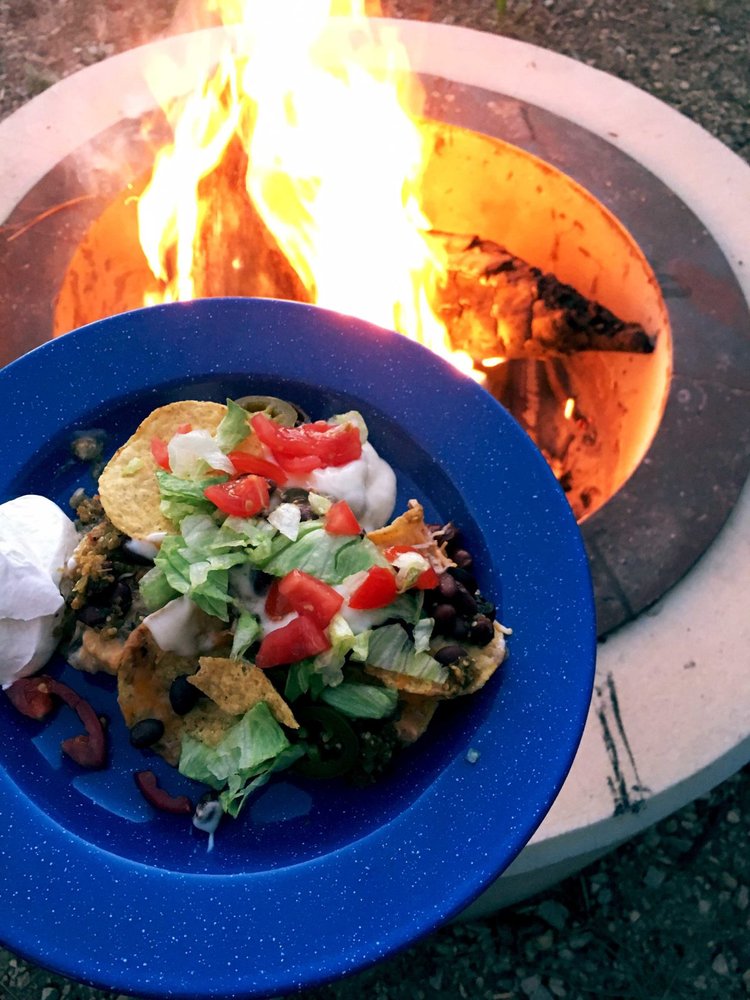
Dutch Oven Nachos
Ingredients
- 1 bag tortilla chips
- 1 can beans, any style including black, red kidney, pinto, or refried
- Half pound meat, your choice of chicken, pork, steak, chorizo, sausage
- 2 cups shredded cheese
- 1 can nacho cheese
- !Additional topping suggestions
- 1 can sliced black olives
- 1 shredded carrot
- 1 jar pickled jalapenos
- 1 shredded zucchini
- 1 can diced pineapple
- 1 diced tomato
- !Fresh ingredients
- Cilantro
- Sour Cream
- Avocado
- Salsa
- Lettuce
- Diced tomato
Instructions
- Heat charcoal briquettes in charcoal chimney until top briquettes are just starting to turn grey, about fifteen to twenty minutes.
- In a 12 or 14 inch Dutch oven, pour a very thin layer of nacho cheese in bottom of pan.
- Add single layer of tortilla chips.
- Top chips with layer of shredded cheese.
- Add half of the can of beans.
- Add meat, if desired.
- Add additional toppings such as sliced jalapenos or black olives.
- Create a second layer of chips, cheese, beans, meat, and other toppings.
- Finish nachos off with a single layer of chips, any remaining cheese, and the rest of the can of nacho cheese.
- Cover with lid and cook over coals for fifteen to twenty minutes. Cook with 8 to 10 coals on bottom of oven and 6 to 8 coals on the top.
- Serve with additional fresh toppings.
Carne Asada Pronghorn
Carne Asada Pronghorn. When translated directly to English, carne asada means "grilled meat." However, the term in Spanish can mean several things. Carne refers to meat and asada refers to barbeque techniques as well as idea of social gatherings that occur when a barbeque is held. So the term can not only refer to the actual grilling of meats, but also to the idea of a social gathering to share and enjoy a family meal.
"My favorite memories growing up in North Carolina were hunting and fishing with my father and brothers. There, I developed a deep appreciation for protecting land and waterways. There, I learned outdoorsmanship." ~ Louis BaconCarn
I found this second definition particularly thought-provoking. Gathering to share a meal with good company is a universal language and a tradition important to many cultures. In the United States, we have holidays dedicated to just this tradition. At Thanksgiving, families and friends gather to share recipes, stories, and traditions around a table stuffed with turkey, mashed potatoes, and whatever casserole has been passed through the family for generations. In Mexico, families gather to show respect for the departed during Dia De Los Muertos (Day of the Dead) by constructing altars in their homes. The altars are adorned with the deceased's favorite foods, drinks, and treats. In Italy, the Feast of Seven Fishes is celebrated on Christmas Eve. This dining event, which dates back to Medieval times, hosts a seven course meal centered entirely around fish. The list is endless and includes all cultures.
Barbeques are just simpler versions of these usually oversized traditions. I know for myself, if I am going to fire up the grill I suddenly start inviting the entire neighborhood. It doesn't matter how last minute the plans are, or how simple the meal is going to be. If I am just throwing a couple of burgers on, I still feel the need to invite my parents over. If I am preparing some grilled kabobs, I am also calling my friends over to share in the event. Barbeque just begs for you to call up friends, share some stories, and enjoy an evening out in the backyard.
I had never made carne asada before. I have tried it several times in different restaurants, and it is always good. When I started looking for some different recipes on how to prepare the meat, I came across the origin and definition of the word carne asada. That translation of "social gathering" made the meal seem even more special. And in true barbequing fashion, I called my family and invited everyone over for an evening of carne asada, story sharing, and a break in the backyard from the rest of the world. Ahhhh, nothing like a backyard barbeque!
A little trick I learned awhile ago is when mincing garlic you can also just grate it with a plane file. This is a bit faster than mincing and you don't have to dirty an entire cutting board just for garlic.
Traditionally, carne asada is prepared from beef steak. The cuts used are usually the more tender steaks, such as skirt, flank, or flap steak. The meat marinades for at least 24 hours, but sometimes for a couple of days. It is grilled over an open flame at a high temperature in order to char the flavors of the marinade and seal in the juices. After searing the meat, it is cooked to well-done. It is typically served on a tortilla with salsa, guacamole, beans, and onions.
Putting the steaks in a Ziploc bag make for easy storage in the fridge. It also creates an easy way to really massage the marinade into the meat.
To create a twist on the traditional carne asada, I decided to make it using pronghorn! Pronghorn is an amazing meat to use for carne asada. It is extremely tender, and takes the marinade really well. For this recipe, I used two cuts of some backstrap and then also a flank steak. It was about two pounds worth of meat, perfect for sharing with a group of six.
The key to a great carne asada is allowing the meat plenty of time to marinade. I set my marinating meat in the fridge 24 hours before I was planning on grilling it. If you are pressed for time, or just decide you want to make this the morning before your barbeque, I think 12 hours would be fine. You could also go longer than 24 hours too.
There is no strict way to marinade carne asada. Different recipes call for different ingredients, and as with most marinades, you could also add things as you go along. I like to taste my marinades and then add to them as the flavors start to develop. Some marinades call for lemon and lime juice, Worcestershire sauce, and a variety of spice rubs. I like my carne asada to have a little heat to it, but also a subtle hint of sweetness.
For my marinade, I juiced two oranges, a lemon, and two limes. To the juice, I added half of cup of coconut aminos, which is where the little bit of sweetness comes from, four cloves of garlic, three tablespoons of chipotle sauce, chili powder, cumin, oregano, black pepper, and sweet paprika. I chopped up a handful of cilantro and then whisked in a half a cup of extra virgin olive oil. Set aside a cup of the marinade for serving alongside the meat. I placed the cuts of meat in a large freezer bag, poured the marinade in, gave everything a nice massage, and placed it in the fridge for the next day.
Preheat the grill really hot. I got mine up to about 550 Fahrenheit. I also have one other little tip before you throw the meat on the grill. Pull the meat out of the fridge about fifteen or twenty minutes before you are going to start cooking. Allow the meat to come to room temperature. This will take the cool from the fridge off the meat and allow you to get a more even heat throughout the steaks. Place the steaks directly on the heat source and cook on each side for one to two minutes. You are looking for grill marks and even a little char on the steaks.
After searing the steaks, move them to an area on the grill with less direct heat. This may be off to the side, away from the flame, or you may have an upper rack level on your grill. My grill has this upper rack, so I moved them there. Close the lid and allow the steaks to slow cook for a few more minutes. How long you allow them to cook will depend on the steaks' thickness. My steaks were about an inch to an inch and a half thick, so I cooked them for seven to ten minutes. Once the steaks reached medium, which I tested with a meat thermometer, I pulled them. Place aluminum foil over the steaks, creating kind of a tent with the foil, and allow them to sit for five more minutes. Allowing the meat to sit for a few minutes gives them a chance to finish cooking, which brought my steaks to about medium-well, and also helps to seal in the juices. If you cut the steaks immediately after pulling them off the grill, the juices rush out of the steak and that is a very sad thing! The meat will also be easier to cut if you let it cool down a bit, and you won't tear it with the knife.
Working across the grain of the meat, slice the steak into quarter-inch thick slices.
To serve the carne asada, lightly grill up some corn tortillas. You could also use flour if you prefer them. Place a few slices of meat on the tortilla and pile on your favorite toppings. I sliced up some fresh jalapenos for extra heat. I also offered more fresh cilantro, grilled bell peppers and onions, shredded cabbage, salsa, sour cream, guacamole, and queso fresco. Oh! And don't forget to spoon on some of that marinade you set aside! It is an amazing little pop of flavor!
Happy Hunting!
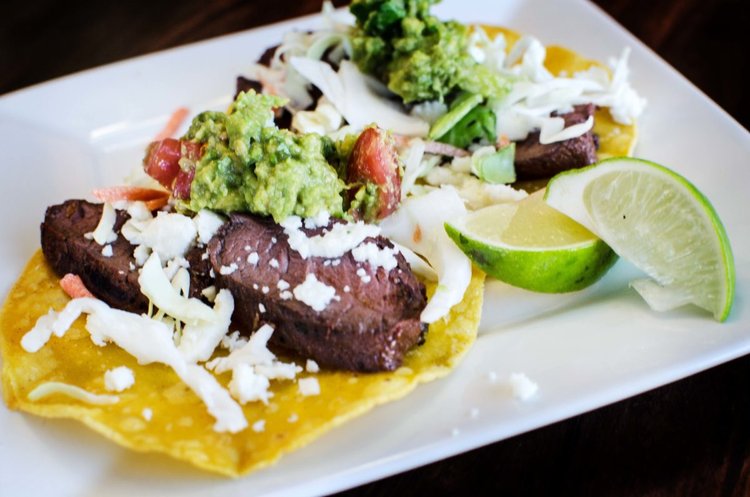
Carne Asada Pronghorn
Ingredients
- 2 pounds pronghorn steaks
- 2 oranges, juiced
- 1 lemon, juiced
- 2 limes, juiced
- 1/2 cup coconut aminos (If you can't find this, you could also use soy sauce. It just won't add the slight sweetness coconut aminos will)
- 4 cloves garlic, grated
- 3 tablespoons chipotle sauce
- 1 tablespoon chili powder
- 1 tablespoon cumin
- 1 teaspoon oregano
- 1 tablespoon sweet paprika
- 1 tablespoon black pepper
- 1 cup chopped cilantro
- 1/2 olive oil
- Tortillas, corn or flour
- Shredded cabbage
- Salsa
- Sour Cream
- Guacamole
- Grilled Onions
- Grilled Bell Peppers
- Queso Fresco
- Chopped Fresh Cilantro
- Sliced Jalapenos
Instructions
- Start your meat marinating 24 hours before you plan on grilling.
- For the marinade, add the orange juice, lemon juice, and lime juice to a medium size bowl. Add coconut aminos, grated garlic, chipotle sauce, chili powder, cumin, black pepper, paprika, and oregano to the bowl.
- Chop and drop in the cilantro.
- While whisking, slowly drizzle in the olive oil. Whisk until fully incorporated.
- Set aside one cup of the marinade for serving with the meat.
- In a large freezer bag, add the steaks and marinade. Massage gently and place in fridge for 24 hours.
- When ready to grill, set the meat out about fifteen minutes before hand.
- Preheat the grill to 550 degrees.
- Place steaks directly on heat source. Sear meat for one minute per side. You are looking for grill marks and char.
- Move the steaks to an area with less direct heat, such as the sides of the grill or an upper rack. Close the lid and allow to cook for seven to ten minutes, depending on the thickness of the meat and how well-done you desire the steaks.
- Remove the meat from the grill and tent with aluminum foil. Allow to sit for five minutes.
- Thinly slice steaks and serve with desired toppings on tortillas!
Foil Wrapped Trout Packs
I am a planner. I like to know what lies ahead and how I am going to get there. I employ this attitude in almost everything I do in life. Stepping outside the plan is difficult for me, especially if I am not prepared for stepping outside the plan (somehow that doesn't even make sense, but if you are planner then you know what I am talking about!).
“The only real stumbling block is fear of failure. In cooking you've got to have a what-the-hell attitude.” ~ Julia Child
Camping is a planner's dream, or nightmare depending on how you look at it. I make lots of lists, trying to think of the unexpected popping up and how I will be prepared to tackle it. I try to cover everything I would could possibly need. Everything is broken down into lists, which have sub-lists, and then the lists are checked through, usually twice. For cooking, there is the master list of each meal: breakfast, lunch, dinner, dessert, and snacks. Then each meal is broken into two sub-lists: ingredients and tools. And then there is another list entirely for stocked items that I try to take everywhere. Things like cutting boards, knives that actually cut things (as opposed to most camping knives that tend to just tear things! I hate that!), extra bowls for mixing and such, spatulas, aluminum foil and Ziploc bags. The list is an ever evolving task that is added to each time a new hunting or camping trip happens.
With all that said, this past camping trip presented an unexpected. I never plan on catching fish. I consider myself a bad luck fisherman actually. Everyone around me can be reeling them in, and I will sit idly watching happy faces pull in beautiful fish. I would say it makes me sad, or jealous, or angry, or something, but I actually am used to it by now. So, you can imagine my surprise when this past weekend I limited out on rainbow trout two days in a row.
Since I never plan on catching fish, I never plan on cooking fish while at camp. This time was different. As I was cleaning the trout, I had this overwhelming urge to have fresh lake caught fish that night. I didn't know how it was going to happen, or if I had anything to prepare the fish with, but I knew it needed to happen. I needed to ditch the planned dinner and make a fish dinner.
Since supplies were limited, I decided to try and cook this fish in foil packets in the actual fire pit. I have done other meals this way before, usually ones filled with meat, potatoes, vegetables, and a gravy base. It is a quick way to make a fantastic tasting meal. It requires little preparation, little clean-up, and amazing results. I had never done fish this way before though.
Besides having no set way to cook this fish, I also had no recipe. So, this impromptu meal was going to have to be a "clean out the cupboard" type effort. I searched through bins for whatever spices and ingredients I could find. This recipe is what I came up with, and I have to say it was superb. I felt like I was eating at a five-star restaurant.
To start, you have to build a fire. This is usually a given at a campsite, but I thought I better mention it. If you aren't much a fire chef, which I can't say that I am one, you can also heat up some coals and just place the packets on top of the coals. I used my charcoal chimney for my dutch oven to heat up about ten coals and cooked over those. It worked great.
For this recipe, I left the fish on the bones. It makes for each fish cleaning, cooking, and the meat literally flakes off the bones once it is finished cooking.
To start, cut two pieces of aluminum foil about twice the size of fish. There needs to be enough foil to fold over the entire fish and other ingredients and then wrap the edges closed. The fish should be centered in the piece of foil with at least an inch of room around it. You want to use two pieces of foil to create a really good barrier between the heat of the fire and the fish. I have single layered the aluminum foil before and things tend to burn rather than steam.
Salt and pepper the fish. If you have some lemon pepper, which is a common seasoning used for fish, that would be great. You could also do my go-to favorite, Montreal Steak Seasoning. I put that on everything because I appreciate the balance of salt and pepper it has. Once the fish is seasoned, add thin slices of onion. Since this is an impromptu menu item, you might not have onions. You could also do minced garlic. Even dried onions or garlic would work, which is something many people leave stocked in their camping supplies. I tend to always take onions with me when camping because they can be added to many different dishes.
On top of the onion, places thin pats of butter. My slices were cut about a 1/16 of an inch thick. You could cut the pats thicker and just not place as many on top of the fish too. I ended up with about five mirco-thinly sliced pieces per fish. It was a good amount of butter. Oh, just a quick note. The butter I had was unsalted. If you used salted butter remember to not add more salt to packet or you could end up with a very salty dish.
Gently pour a good drizzle of Worcestershire sauce over the fish. It is okay if it just pools up below the fish. Once sealed, the packet will steam everything and the sauce will infiltrate the fish beautifully!
To create the packet, fold the foil over the top of the fish. Gently start rolling the edges of the foil towards the fish, taking care not to puncture or rip the foil. The foil has to be completely sealed or the juices will run out and things won't cook right. If you tear a whole, grab another piece of foil and add another layer to the packet. The best way to think about making packets is to just try and keep things pretty. The prettier the packet, the better things seem to hold together.
Cook the fish about five to seven minutes per side. This will ensure the fish is flaky and pink, the onions are soft and sweet, and the butter and Worcestershire have melted into a delicate sauce. When I was cooking, the packets actually puffed up when they were finished, which was also a good indicator that things were done. However, if there are any leaks in the packets, this won't happen so I would keep an eye on the timer.
For a quick side dish, I cooked up some cheesy dutch oven potatoes. Cube the potatoes into bite size pieces, season with salt and pepper (or as I did, because like I said I am crazy, you can add Montreal Steak Seasoning. I have a problem.), and cover with cheese. You could also throw in some onion if you have left-overs from the fish packets. Cook over coals, about ten to twelve on the bottom and eight to ten on the top, for twenty to thirty minutes, or until the potatoes are soft.
Happy Hunting!

Foil Wrapped Trout Packets
Ingredients
- 4 full trout, skinned and on the bone
- 1 onion, cut into thin slices
- salt and pepper
- 1/4 stick butter
- 4 tablespoons Worcestershire sauce
Instructions
- Light your campfire or charcoal coals.
- For each fish, cut two pieces of aluminum foil. Foil should be twice the size of the fish.
- Place fish in center of foil.
- Salt and pepper each fish.
- Place slices of onion along the fish.
- Cut butter into thin slices and lay atop the onion.
- Pour a tablespoon of Worcestershire over fish. Repeat with other three fish.
- Cook packets over the fire or coals and cook for five to seven minutes per side, flipping half way through the cook time, until fish are flakey and red. Onions should be soft and sweet. Enjoy!
Pheasant Mushroom Soup
Pheasant Mushroom Soup. It’s creamy, hearty, and filling. I love a bowl of it on a cold evening, but even more so on an evening after a long day of pheasant hunting! Or deer hunting. Or elk hunting. Or even just afternoon of hunting around Netflix for new show to binge on a cold Saturday. Anyway, the point is, this is an amazing soup!
Pheasant Mushroom Soup
Pheasant hunting in Utah has been, ummm, I will say interesting for the last few years. Years ago, the state carried a healthy population of pheasants. My dad told me he remembered as a young boy standing in a line of hunters and dogs, anxiously waiting for the pheasant season to officially open. The clock hit 8:00 am and the entire line moved across the field, attempting to kick up roosters, and fill their bag limit of two birds.
Since then, the bird population has struggled. Multiple factors play into this decline, including habitat destruction, predation on birds, tough winters, and more. In southeastern Utah, where I live, the population has almost completely disappeared. There may be a few lone birds out in the once popular hunting areas, but I wouldn’t even go searching for them in fear that if I did find a rooster, I was taking the very last one.
The state department of wildlife has addressed the decline and implemented a release program for pen-raised roosters. During the pheasant season, they release about 10,000 birds over 54 different hunting areas throughout the state. The program has made it possible to hunt pheasant again around the entire state of Utah, which has been great!
Anyway, politics aside! Let’s make Pheasant Mushroom Soup
The Mushroom Stock
You could easily add vegetable or chicken stock to this recipe if you wanted. You could even probably find a mushroom stock at most grocery stores but making your own is really quick and easy. The few steps it takes to make a quick homemade mushroom stock really adds to the depth of flavor for your soup, so if you have the ingredients, I recommend this step.
In a small saucepan, add all the stems from your mushrooms. Cover with water, about four cups.
Also add in a few, like two, roughly chopped up carrots, a little celery, some onion, and a bay leaf. Season with a little salt and let reduce over medium low heat for at least thirty minutes.
Strain out all the solid and reserve the liquid for your pheasant mushroom soup.
The Pheasant Mushroom Soup
To help ensure that the pheasant is tender and easily shreds, I poach it first. In a large pot, I add enough water to cover the pheasant, which is still just on the bone at this point and poach it for one hour.
For poaching, add enough water to cover all the pheasant and bring the water to a boil. Once the water is boiling, place a lid on the pot, reduce the pot to a simmer over low heat and let the poaching begin.
I just use water for poaching because the mushroom soup is going to add all the flavor to the pheasant. You could use vegetable or chicken stock to poach in, but it is almost a waste of stock. This was a hard tactic for me to follow at first, in my bones I felt like I needed to flavor the pheasant while poaching. But I resisted! And saved my stock for another day.
Once the pheasant is finished poaching, you can shred it into bite size pieces and set aside for adding to the mushroom soup.
In a dutch oven or heavy bottomed pot, melt two tablespoons of butter and a tablespoon of olive oil over medium heat. Once the butter is melted, add the minced shallot and diced leeks, and cook for two or three minutes. Add your diced carrots, and add all the sliced mushrooms at this point, being sure to stir and coat the mushrooms in the oil and let cook down for ten minutes.
The mushrooms should be browned and softened by this point.
Sprinkle a little flour over the cooked mushrooms. This will be how we thicken the soup. A quarter of a cup should be good enough. Next, deglaze the pan with a half cup of marsala wine. I really liked the marsala wine in this recipe because it has kind of a sweet, musky flavor that dances wonderfully with the mushroom flavor. Let it simmer to cut some of the alcohol out and the develop the flavor of the mushrooms, maybe three to five minutes.
Now, add in your homemade mushroom broth! If you don’t have time to make your own mushroom stock, you can add vegetable or chicken stock at this point. Some homemade pheasant stock would also be fantastic!
Okay, now stir in your pheasant meat and let this pot gently boil for twenty minutes. No need to have a little jetted hot tub going on, just a gentle rolling boil will do.
Alright, we are almost done! I know you’re getting hungry! Add the can of coconut cream and a tablespoon of minced rosemary. Season to taste with a little salt and pepper. Let it warm on medium low heat for a little bit, just to give the mushroom flavor a little more time to infiltrate your pheasant and tango with the coconut cream.
Serve up piping hot bowls with some crusty bread and you will be one happy eater! Enjoy!
Happy Hunting!
Wild Game Bone Broth French Onion Soup
Wild Game Bone Broth French Onion Soup. After the sun has pulled the covers up and tucked itself in for the nigh and the cold starts to set in, does anything sound better than warm soup? I don’t think I feel happier and cozier than when I have my hands wrapped around a steaming bowl of French onion soup topped with gooey, melty gruyere cheese and homemade wild game bone broth.
Wild Game Bone Broth French Onion Soup
French onion soup is an OLD dish. Like think 8,000 years old. There are many different versions of how it first came around, but my favorite is the one where King Louis XV returns from deer hunting to bare cupboards. He rounds up some onions, butter, and champagne (which seems odd that his cupboards are bare, but champagne is around, but anyway), throws it all in a pot, and voila, French onion soup is born.
French onion soup was commonly considered the food of the poor because onions were cheap, easy to grow, and plentiful throughout Europe. The soup became popular in the 1960s in America along with the nation-wide trend of French cuisine in general.
To me, if French onion soup is the food of the poor, I don’t want to be rich. It’s one of my favorite meals. The ingredients are simple and easy to find, but the flavor developed from simply simmering caramelized onions in silky bone broth is downright amazing!
So, without wasting more time, let’s make Wild Game Bone Both French Onion Soup!
The Wild Game Bone Broth
You can make this recipe with store-bought beef broth, which is fine, but this is a wild game website, so I am going to share really quick (like the condensed, superfast version) how I make homemade wild game bone broth. I make a huge batch at one time from any of the bones I have in the freezer. Many times, the broth will be a combination of elk, deer, and pronghorn bones.
I roast the bones in a 400-degree Fahrenheit oven for one hour. I also do two or three onions, just cut in half and you don’t even have to remove the skin, and a couple of big chunks of ginger, I don’t even peel it.
After the bones are roasted, I put them, the onions, ginger, about six carrots, a bunch of celery, a couple of star anise pods, and a handful of whole cloves into a large stock pot. I cover everything with water, so this could end up being up to 24 cups of water if the pot is large like mine, and let it start simmering for hours. When I say hours, I mean like six. I reduce the liquid by about three quarters. Pour through a fine mesh sieve and scrape any fat from the top.
I don’t add salt to my bone broth. I just salt it when I use it so I can get it the way I like. Also, because it is so concentrated after hours of simmering, it doesn’t take up much room in the freezer. I freeze it in little pint-sized containers and then when I use for a recipe later, I add back in the water. So, for a pint of broth, I would add eight to twelve cups of water back in, depending on what I am doing.
Let’s Make French Onion Soup
Now that the broth is ready, it is time to start the onions. To a large skillet over medium heat, add a couple of tablespoons of olive oil, enough to coat the entire base of a ceramic dutch oven, and a tablespoon of butter. Once the butter is melted, add the onions. I slice the onion into long strips for this soup.
Spread the onions out and make sure they are coated in the oil. Let them cook for ten minutes, stirring often to keep them from sticking to the pan or burning. If they are cooking too quickly, you may need to reduce the heat a little. You are looking for a slow caramelization here.
After ten minutes, sprinkle a tablespoon of salt over the onions to develop even more flavor. I also add a teaspoon of sugar. It helps with caramelizing. Cook for twenty minutes more.
Once the onions are golden, and caramel-y, and smell like heaven, they are ready. Deglaze the pan with a cup of wine, red or white will work here, and be sure to scrape all that flavorful goodness from the bottom of the pot.
Add the pint of reduce wild game bone broth and eight to twelve cups of water. Bring to a gentle boil, and we will add even more flavor to this dish! Add two tablespoons of Worcestershire sauce, a tablespoon of Italian seasoning, and salt and pepper to taste.
Reduce the mixture for thirty minutes on a simmer. Add a quarter cup of sherry.
While your soup is doing its thing, toast sliced pieces of French baguette in the oven. I toast them under the broiler for five minutes. If you brush them with a little butter or olive oil first, you will get a beautiful, crunchy golden crust.
It’s time for the fun part: melting the cheese. Fill an oven safe ramekin with a cup or two of the French onion soup base. Nestle a few pieces of the toasted French bread into the soup, and then top it with shredded gruyere cheese. I do a ramekin per person.
Place the ramekins in the oven at 350 degrees for about ten minutes. The cheese should be melted and slightly browned (cue drool), and the broth slightly boiling. Aaaannnndddd…it’s time to eat!
Happy Hunting!
If You Like This Recipe, You Might Also Like…
Bear Shank Osso Buco
Bear Shank Osso Buco. It is a meal so commanding that just the name is a sentence of its own. I can’t think of a dish that I feel more comforted by and calm while preparing, but at the same time have zero patience as I wait for it to finish in the oven. It is, to me, the definition of comfort food.
Bear Shank Osso Buco Final Plate
Translating from Italian to English, Osso Buco literally means “bone with a hole” because the dish is the braising of the shank from an animal. The shanks are crosscut, exposing the marrow hole of the bone, and the meat surrounding the bone is tough. Osso Buco takes these two unique aspects of the cut of meat, the still intact marrow of the bone and the ligament filled tough meat, to create a very flavorful, hearty, and tender dish.
Though not a traditional Osso Buco, this Bear Shank Osso Buco is packed with a full flavor experience! The bear shank is tender and savory, the sauce is rich and silky from the bone marrow but also incredibly flavorful from the spice mixture, and the polenta is creamy and cheesy. It also isn’t too hard to pull off!
The hardest part of preparing Bear Shank Osso Buco is the wait. You brown your shank, chop up your vegetables, put all the kids in the dutch oven swimming pool, and then…you wait…for hours.
The wait is definitely worth it, but man-oh-man does it feel like forever.
Osso Buco’s story starts from Celtic origins and the culinary tradition of Lombard cuisine. Lombard cuisine, developed mostly in the Lombardy provinces of Italy, but this cacophony of cooking influences across centuries of cultures is a collection of rices, pastas, soups, risottos, and polenta. The cuisine is extremely varied, but utilizes a lot of butter, oils, and other cooking fats. It is also known for dishes that are “low and slow” such as braised meats and stews.
A traditional Lombard cuisine Osso Buco is a veal shank slow braised in white wine and broth with carrots, onions, and celery. With this simple presentation, the marrow is the star of the show.
This Bear Shank Osso Buco recipe has a little bit more going on than a traditional Osso Buco, but it was built using the blocks of a traditional Osso Buco with a little “adjusting” to help the bear shank shine a little more.
Let’s Make Bear Shank Osso Buco
So, let’s get started. Preheat the oven to 325 degrees Fahrenheit. Also, preheat your dutch oven over medium heat. Once the dutch oven is hot, add about a half cup of chopped pancetta and brown until just crispy. Remove the pancetta and set to the side, but reserve the fats left behind for cooking the rest of the dish.
Lightly dust your bear shank in a mixture of flour, salt, and black pepper. Place the coated bear shank into the pancetta fat and brown five minutes per side. If your pancetta didn’t leave enough fat behind for browning your bear shank, add a little oil or butter to the pan.
Remove the browned shank and set aside. To the dutch oven, now add one large diced onion, four diced carrots, four diced stalks of celery, and a large minced shallot. Coat everything in the leftover fats and oils and let cook for five to seven minutes, or until the onion starts to turn translucent.
Braising liquid flavoring: diced carrots, celery, onions, and minced shallot.
Deglaze the dutch oven with a cup of white wine. I always take a minute to bask in the steam from the white wine hitting the hot pan. It smells amazing. I also do that when I put onions into butter. Nothing smells better than onions in butter. Anyway, let the wine cook down for a few minutes to release some of the alcohol, and then add the cup of vegetable stock.
This next step is where we will leave the familiar trail that leads to Osso Buco and add a little flair of our own. Traditionally, Osso Buco does not include tomatoes, but I was just feeling the need to have some tomatoes. I added a pint of cherry tomatoes to the dish. Season to taste with a little salt and pepper. It is also time to add our little bundle of spice joy.
To make your own little bundle of spices, cut a square from cheese cloth and get yourself some twine. You can leave the spices whole because you will pull the entire little bundle from the pot at the end of cooking. My little bouquet bundle included a few sprigs of fresh thyme, a stem of fresh rosemary, a little piece of mace, two bay leaves, a full star anise, and five whole cloves. Tie it up, take a moment to say “Awww” at how cute it is, and drop it into the pot.
Spice bouquet bundle: star anise, whole cloves, thyme, rosemary, mace, and bay leaves
Finally, nestle the bear shank back into the liquid and cover. The liquid should reach about halfway up the shank at all times, so you might check it throughout the braising process to ensure the liquid stays full enough. Shanks are a pretty tough cut of meat off most animals. They are also full of ligaments and tendons, which aren’t always the most appealing items to find in a dish; however, braising actually uses the “flaws” of a shank to the dish’s advantage. The slow cooking at a low temperature in basically a sauna of braising liquid takes the shank meat from tough to tender, sweet, and just a little caramelized from the initial browning. It also breaks down the tastier parts of the ligaments and tendons, releasing collagen into your braising liquid and thus laying the groundwork for a very flavorful and hearty gravy for your final dish.
Slide your dutch oven into a preheated oven to 325 degrees Fahrenheit. Let the shank cook for at least three hours. The shank should be falling apart when you pull it out of the oven. It should be fork tender and shred easily.
Let’s Make Cheesy Polenta
About thirty minutes before your shank is ready to serve, start the polenta. I am in love with cheesy polenta. It is so creamy, a little salty, and soaks up the liquid of anything you top it with. It’s delicious!
You want to make sure your polenta cooks for about thirty minutes so you can start to really break down the corn bits. You want smooth and creamy here. If you do the quick cook recommended on the package, you will end up with chewier and even a bit hard polenta, which is fine, but trust me the slow longer cook is worth the time and effort.
Add three cups of water to a saucepan and a teaspoon of salt. Bring to a boil and then whisk in your cup of polenta. Stir constantly while the polenta thickens. Turn the heat down to low and let the polenta slow cook for up to a half an hour, the longer the better. Stir it frequently to keep it from sticking to the bottom. If it starts to get to dried out, add a little more liquid.
Right before you are ready to pull the polenta from the stove, pour in a cup of cheese. I used gruyere for this dish. The salty but tangy flavor of gruyere sounded perfect with the spice bouquet used to braise the bear shank.
Whelp! It’s time to plate up this bear shank Osso Buco. I can hardly wait! Put a heaping scoop of cheesy, gooey, creamy polenta in a shallow bowl. Add chunks of tender, savory bear shank meat over the top and then drench in the braising liquid gravy. Be sure to get plenty of carrots, celery, and tomatoes. Sprinkle with pancetta bits and fresh minced parsley.
Finally, time to dig in!
Happy Hunting
If You Enjoyed This Recipe, You’ll Also Like…
Venison Stuffed Shells with Apple and Butternut Squash Sauce
I love the combination of squash and apples. The melded flavors are comforting, warm, savory, and just a little bit sweet. I think when the duo is mentioned many people think of a pie, a sweet and rich auburn pie served for Thanksgiving. But squash and apples don’t always have to be a dessert. They can create a rustic, homey dish like this Venison Stuffed Shells with Apple and Squash Sauce.
This dish takes a little bit of time to pull together, but the end result is worth the effort. To start, cook a medium sized butternut squash in oven at 400 degrees Fahrenheit for 45 minutes. I cut the squash in half and place the squash cut side down on a large baking sheet. You can also line the sheet with aluminum for easier clean-up, as sometimes the squash weeps a little when roasting.
Remove the squash from the oven and let cool slightly before handling. I like to play Russian roulette with the squash and try to pick it up before it has properly cooled, usually resulting in burned hands, but that’s just me.
While the squash is cooling, prepare the venison sausage for stuffing the shells with. In a large skillet over medium heat, add some cooking oil, I like to use olive oil for this particular recipe but work with what you have. Once the oil is heated, add a medium diced onion and cook for five to seven minutes, or until the onion is soft. Next, add in the venison Italian sausage.
I make my own sausage. I grind the venison with bacon ends at a ratio of 80% meat to 20% bacon ends. This gives the sausage a nice fat content that isn’t overly greasy or fatty, but keeps the sausage moist when cooking. I season the sausage with salt, black pepper, crushed red pepper flake, Italian seasoning, allspice, garlic and onion powder, and plenty of fennel seed. I also add touch of brown sugar to sweeten it up a bit.
This recipe requires a pound of venison Italian sausage. Add the sausage to the onions and cook thoroughly, about five to seven minutes again. Once the sausage is cooked through, add a half cup of chopped pecans, a tablespoon of fresh minced sage, and a tablespoon of fresh minced rosemary. Stir together, turn off the heat, and set aside to cool.
While the sausage mixture is cooling, cook your pasta shells. I used jumbo pasta shells for this recipe, but you could also use manicotti. If you are really ambitious, you could make these into raviolis as well. Cook the shells to al dente, where they are soft but not falling apart.
Drain the shells and set aside to cool. As with the butternut squash, I played Russian roulette with the shells and tried to stuff them before they were cool enough for handling. It didn’t feel great.
Wow there are a lot of steps here, but bear with me, it is going to be worth it. Return to the cooled sausage mixture and mix in a container of ricotta cheese. Set that aside.
Back the squash! Scoop the squash guts into a blender and add a little salt and pepper for flavor and half cup to three quarters of a cup of stock. I used a vegetable stock. You could use chicken too if that is what you have on hand. If you were really fancy, this would also be a perfect opportunity to throw in some homemade bone broth.
Blend the butternut squash into a smooth puree. It should still hold together, so add the liquid slowly until you reach a consistency similar to the applesauce. Add the butternut squash puree to a large skillet with a cup of unsweet apple sauce. Turn the heat on medium low and stir until the sauces are combined. Slowly drizzle in a quarter cup of heavy cream and stir until a smooth, creamy, orange sauce forms. Add a cup of parmesan cheese and mix until completely melted.
Stuff the shells with the sausage mixture. Spoon a quarter of the apple and butternut squash sauce into the bottom of a 9x13 baking dish. Set the stuffed shells on top of the sauce. Once all the shells are set, pour the remaining apple and butternut squash sauce over the top and then sprinkle on a layer of mozzarella cheese. Bake in a 350 degree Fahrenheit preheated oven for 30 minutes, until the cheese is gooey and the sauce is bubbling!
And now! Time to enjoy! This dish is creamy, rich, and savory. It has hints of squash and apple layered with cheesy goodness and fresh herbs. It is one of my favorite dishes to serve for a crowd because it is easy to make large batches and is incredibly filling.
Happy Hunting!
If You Like This Dish, You Might Also Like….
Elk Reaper Summer Sausage
My favorite boating snack is definitely summer sausage, Ritz cracker, and a slice of cheddar cheese. It’s actually my favorite hiking snack. And fishing snack. And hunting snack. And sitting on the porch at the end of the day snack. And bored at home snack. It’s just the best snack. It’s even better when it’s made from your own harvested wild game too! And it’s even better than that when you add home grown Carolina Reaper peppers for Reaper Elk Summer Sausage.
I started making my own summer sausage about a year ago. Store bought is okay. Getting it from a butcher is better than store bought. Having a butcher that processes wild game make you some from your own meat is even better than that. But the best is absolutely making it yourself. You get to control the salt level, the cuts of meat that go into it, the fat content, and the spices.
I feared the summer sausage process to begin. It seemed daunting. I also had a really difficult time finding a solid recipe online. And smoke times and temperatures? Almost impossible to find. I got incredibly lucky that a person on Instagram reached out to me and shared smoke times and temperatures.
So, after a few practice runs and some recipe perfecting, I am ready to share my Reaper Elk Summer Sausage recipe.
Homemade summer sausage is pretty easy to pull off, but there are a few tricks that make it turn out fantastic instead of just good. First tip: keep your meat and fat very cold! This is one of the most important steps for making summer sausage. If things get to warm while you are working the fat will separate and ruin the texture of your final product. So, between each step of mixing and grinding I stick the meat into the fridge for about thirty minutes.
Okay, let’s start making some Reaper Elk Summer Sausage. Following the first tip of summer sausage making, start with cold meat and cold fat. This recipe will make four summer sausage sticks that are two and a half pounds each. I do a ratio of 20% fat to 80% meat. So, for this recipe you need eight pounds of wild game meat of your choosing and 2 pounds of fat.
For the fat, most people prefer pork fat. I have never had the opportunity to work with pork fat as it seems nearly impossible to acquire. I have asked the local supermarkets and butcher, and all that is ever available is beef fat. So, I have only used beef fat, but it works great in my opinion.
For this recipe, I used elk for the meat. I have also done deer, bear, and pronghorn. They all turned out amazing. So, use whatever is in your freezer and you won’t be disappointed.
Run your meat and fat through a grinder using a coarse plate first. I used an 8mm grind plate. I also have a very inexpensive meat grinder. I love it. It didn’t break the bank, doesn’t take up much space, and is convenient enough to use I can just pull it off the shelf and grind up fresh burger meat at a moment’s notice. The grinder I am currently using, and have for quite a few years, is just this one: Cabelas Deluxe Meat Grinder.
Give the meat a quick mix to get the fat and meat incorporated. It is also time to add the spices now! I love the spice mixture for this Reaper Elk Summer Sausage. It obviously is spicy. The Carolina Reapers add a slow building heat to sausage that definitely lights your mouth up for a bit, but if you like a little kick you will thoroughly enjoy the reapers.
The allspice and cloves add a little sweetness and a slight touch of bitter, which pairs wonderfully with the heat from the Carolina Reapers. Pair that heat, sweet, and touch of bitter with the tang from the fermenting agent for summer sausage and you have one tasty snack on your hands.
Continuing on, to your meat and fat mixture add six tablespoons of kosher salt, 4 tablespoons of dextrose, and two teaspoons of pink salt #1. The pink salt extends the shelf life of cured meats, gives everything that pretty red hue, and assists in the prevention of spoilage from bacteria. Dextrose is added to cured meats to feed the lactic acid organisms that create that wonderfully tangy fermented flavor.
Once you have your salts and dextrose mixed in add your seasoning agents: 1 tablespoon of dry yellow mustard, 3 teaspoons of garlic powder, two teaspoons of ground ginger, 2 teaspoons of coriander, one tablespoon of allspice, and two teaspoons of ground cloves.
Next add your mustard seeds. Most people put in about two tablespoons. I eyeball it because I love the texture the seeds add to the summer sausage. I do more like three tablespoons. I also add more freshly cracked black pepper for the same reason. You don’t want to completely over-do it with the pepper because it can change the flavor of the summer sausage, but I do more like a tablespoon while others recommend less.
Finally, it’s time to add your heat! The Carolina Reapers I used for this recipe were from my home garden. I dried them in a window for two months and then ground them into a powder. This recipe used three dried Carolina Reapers, which worked out to one pepper per 3.33 pounds of meat. This is equated to a teaspoon of powder for the entire recipe. I would recommend some gloves at this point.
This recipe is for lovers of the heat! You can adjust the level of heat to fit your personal preference. To drop the heat level, you could add less of the Carolina reapers or use a different type of pepper, such as a habanero, serrano, or jalapeno. If you aren’t a fan of heat at all you can omit the pepper completely.
Get everything mixed really well. If you use your hands, I suggest wearing gloves because of the peppers.
Alright, time for the final steps before we place our meat back in the fridge: the fermenter. There are lots of different types of fermenting agents available. One of the more popular ones is Fermento. I used pediococcus culture. I ordered it online. It is a little spendy, but you can make pounds and pounds of summer sausage from one bag.
There are lots of different options for pediococcus culture. All of them provide protection against listeria and such; however, they all produce different results as far as the sourness of your finished product. There are some that will make your summer sausage very sour and tangy, and others that are much less so. I used a one that created a little less sour flavor since I was adding so many other spices to this summer sausage.
The pediococcus culture needs to be kept in the freezer to survive. You also shouldn’t handle it with bare hands. For ten pounds of summer sausage, I mixed ¾ cup of water with 3 teaspoons of dextrose. I then mixed in 3/8 a teaspoon of the pediococcus culture. Stir until the dextrose is dissolved and then pour over your meat mixture. Mix everything together.
Now that the spices have been added and the fermenting agent, place the meat mixture back in the fridge for thirty minutes to cool the meat back down.
After the meat has cooled, run the entire batch through the grinder a second time on a smaller grind plate. I used a 4.5mm plate. Place the meat back in the fridge to cool once again. I let it sit another thirty minutes even though the meat hadn’t warmed up too much this time. I wanted everything to be nice and cool for packaging the summer sausage.
Switch the grinding plate out for the stuffing accessories. You also need to let your summer sausage casing soak for ten minutes in the sink. This recipe makes basically logs of summer sausage and I then cut them down into smaller blocks before vacuum packing, but the actual casings are quite large. I used the 2 and ½ by 18-inch collagen casings.
It’s time to stuff casings, which leads us to our second tip: pack the casing very tight. Like as tight as you possibly can! The tighter the better.
Once all the summer sausage is packaged, place the logs in the fridge to relax overnight. I didn’t want overly sour summer sausage, so I let mine sit for one evening. If you like sourer flavor, let them sit for two nights before smoking.
So, once you have let the summer sausage ferment and do its thing, it’s time to smoke! Finally!
Preheat the smoker to 135 to 145 Fahrenheit and add your wood of choice. I have a pellet smoker and used applewood to smoke the summer sausage. The third tip for summer sausage success is to use a meat thermometer throughout the smoking process. You want to know the internal temperature of your sausage, so you know when you increase the heat of the smoker and when to pull the meat.
This is a cool temperature smoke for a pellet smoker. I ended up placing tin foil on the rack to direct all the smoke directly at the temperature control probe and then added a rack about an inch off of the tinfoil to create an insulating air layer to prevent the heat from the fire box directly going at the sausage. I then used the probes to monitor the air temperature at each end of the sausage. This ended up working perfect as the control probe is at the opposite end of the stack, so it ended up blowing the smoke across the sausage lengthwise. I know this is confusing. If you need help, email me and I can walk you through it. This was also done in the winter. I do not know that a pellet grill would work in the summer.
Keep the smoker at 140 degrees Fahrenheit for about an hour. This is essentially the “drying” stage of summer sausage. The meat temperature should not raise a lot during this stage of cooking. Keep at this until the internal sausage temp is 80 to 85 degrees.
After about an hour, kick the heat up to 160 degrees Fahrenheit. This is when you will start to get a lot more of the smoke saturation. I let the sausage smoke at 160 degrees for about an hour. The internal temperature should be 140 at the end of this cycle.
Finally, kick the heat up to 180 degrees Fahrenheit and finish cooking the summer sausage. This is where watching the internal temperature is most important. Pull the sausages from the cooker once the internal temperature reaches 154 degrees. This step can take a few hours, anywhere from two to three. A lot of factors affect the cooking time, such as how tightly packed the casing are, the type of meat used, moisture content of the meat, and I’m sure so many other things we don’t even realize. That is why it is important to pull the summer sausage by internal temperature and not cooking time.
Alright, time for the final tip! Immediately upon removing the summer sausage from the smoker, plunge the sausages into cold water. This will help set the meat, resulting in a much better final texture, and makes removing the casings easier.
You don’t have to keep the sausages in the water long, a few minutes is good enough. Before packaging the sausage for storage, let them cool completely, which takes about an hour. To store, I cut them into chunks that I would use for taking on a hike or serving at a party, which is about six-inch-long pieces. I then vacuum package the chunks for freezing. I started vacuum packing the sausage because the first time I made them I just loosely wrapped them in plastic wrap and stuck them in the freezer and they freezer burned after a month. I didn’t take into consideration that the casings are permeable, which I felt I should have thought about because I knew the sausage absorbed smoke so well during the cooking process. Anyway, they freezer burned, which I hate, so I started vacuum packing them after that experience.
Anyway, that is my recipe and process for creating this Reaper Elk Summer Sausage.
Happy Hunting!
Mussels and Shrimp Truffle Pasta
Not living next to the ocean definitely makes seafood a challenge; however, every year, our local small town butcher orders in fresh mussels, clams, and oysters during the last week of December. The mollusks arrive fresh and alive! It is a true desert treat, and I always order my fair share during that time. This year, I used the mussels to make a Mussel and Shrimp Truffle Pasta with a Tarragon Lemon Sauce.
Mussels are a bivalve found in both salt and fresh water. Evidence shows humans have consumed mussels for thousands of years, although steaming up a pot of freshwater mussels for dining on isn’t very popular anymore.
Saltwater mussels are another story. They are prepared many ways, from steaming in white wine and herbs for a seafood feast, to pickled in a salty brine and served on a toasted baguette, to floured and fried on skewers. Like other saltwater bivalves, mussels have that faintly oceanic but sweet taste to them. Their subtle flavor but robust texture makes them a great addition to many different types of meals, whether they are the star of the dish or the understudy.
For this Mussel and Shrimp Truffle Pasta, I decided to let the mussels take on the lead role and showcase all they have to offer. The sauce for dish is simple and understated, but the flavors were all selected for pairing with the mussels.
To start, preheat the smoker or your grill to 500 degrees Fahrenheit. I used a smoker for this recipe so I could impart a little smoked flavor into the mussels, but a grill works perfect for this recipe as well. I used a light wood for the smoking: Apple Wood.
Give your mussels a scrub with a brush under cold running water to remove any sand or rocks from the shells. Discard any mussels that have a broken or cracked shell.
While the smoker is preheating, in a shallow roasting pan or a cake pan, add an entire minced shallot, a cup of dry white wine, half a cup of extra virgin olive oil, and two teaspoons of crushed red pepper flakes. Nestle your pound of mussels and pound of raw shrimp into the liquid.
Once the grill is preheated, place the pan of mussels and shrimp on the grate and close the lid. I didn’t cover the mussels with aluminum foil because I wanted the smoke to penetrate the meat. If you use a grill, cover the mussels with aluminum foil. Steam the mussels and shrimp for ten minutes.
While the mussels and shrimp are cooking, prepare the pasta. I used a truffle pasta. If you can’t find a truffle pasta, you could grate over some truffle or find a truffle oil to add to the dish. The truffle flavor pairs wonderfully with mussels because they also have a slight mushroom flavor.
You also want to fry a up a few pieces of bacon for your finished product. When cooking several pieces of bacon, like for this recipe, I like to just place the bacon on a cookie sheet lined with aluminum foil and bake at 400 degrees Fahrenheit for 12 to 15 minutes, or until the bacon is crispy.
At ten minutes, check the mussels and shrimp. You will know the mussels are done when they are all opened. The shrimp should also be a vibrant pink color. If most of your mussels are open, pull them from the grill and discard any mussels that are still closed. If the majority are not open, close the lid on the grill and let them cook for five minutes more.
Once the mussels are ready to go, head inside to finish up the dish. Be sure to not discard your mussel cooking liquid because this is the pasta sauce. Place the al dente truffle pasta in a large bowl and drizzle the mussel cooking liquid over the warm pasta. Sprinkle on the bacon bites, two tablespoons of fresh minced tarragon, and the juice of one lemon. Toss everything together and then set the mussels and shrimp into the dish. And that’s it! Time to eat!
I love this dish because it is light, but the flavors are so well balanced. The sweet, slightly salty mussels are complimented by the mushroom flavor the truffle pasta, but also pair perfectly with the bacon pieces and fresh tarragon. The acidity from the lemon also pulls the entire dish together. Enjoy!
And Happy Fishing!
Serrano Margarita Oyster Shots
Oysters. They’re a lot. They’re not for everyone. But I think this recipe for a serrano margarita oyster shot definitely helps make oyster eating a little easier on everyone.
Not growing up near a coastline definitely made oysters seem like a completely foreign food item. The only time I saw oysters growing up was the oblong shaped cans of smoked oysters on the tuna shelf in the supermarket. I never ate them. Just saw them.
The first time I tried an oyster was at a Chinese buffet off the highway in Delaware. I definitely made it into a big deal. It was very dramatic. I needed the other restaurant patrons to hear how this was my very first oyster, and how skeptical I was about eating it. It was a lot like when young children try a food for the first time and need everyone to know the importance of the monumental occasion.
After filling my buffet plate with chilled crab pieces and shrimp cocktail, I took a single shucked oyster from its icy bed and placed it almost ceremoniously in the center of the plate. Back at the table, I picked the lone oyster from the plate, clinked it with a quick “cheers” with friends, and attempted to slurp it down.
In the movies, everyone always looks good eating an oyster. It’s almost equivalent to how people make smoking look cool in movies. They take a long, slow drag from their cigarette, roll the smoke around in their mouth, close their eyes in a small moment of bliss, and puff out beautiful smoke rings. Watch people smoke in real life and there is a lot of coughing and smoke kind of billows randomly about. Oyster eating is just like this.
In the movies, oysters are picked up delicately with the thumb and a single finger and then effortlessly, and more importantly cleanly, and quickly slurped, and mind you it is a soundless slurp, from their shell. They disappear quickly with a small swallow and then are followed by that closed eye small moment of bliss.
Real life oyster eating, especially the first time, is not at all like that. First, figuring out how to hold the oyster is a challenge. Every grip feels awkward. Do you clutch it? Do you palm it like a ball? Cradle it? And how do you keep your fingers out of the way of the meat?
After you get your grip, it’s time to slurp. It’s loud. And it’s actually a little embarrassing. Getting the meat out of the shell isn’t as easy as it looks. So you slurp harder and louder. All the liquid usually comes out first, and you choke on that a bit, and then the meat will break loose suddenly. It’s kind of like when you are trying to get the last bit of an icy drink from the bottom of a cup. You shake the cup a few times and eventually the entire block of ice breaks loose and unexpectedly falls all over your face.
My first oyster eating experience was very textbook. I couldn’t find my grip on the shell, and once I did the rest of was loud, a little embarrassing, and awkward. Things only got worse from there. Once I finally got the oyster out of the shell and started swallowing things went from bad to worse. The oyster hit the back of my throat and the texture was just all wrong.
All I could think about was how big, and gooey, and flat-out booger-esque the whole experience was. My mind kept thinking: “Just get it over with. Swallow faster.” Swallowing faster didn’t help. The foreign blob started working its way back up.
So the entire swallowing ordeal started all over. There was more gulping, a little bit of gasping, possibly some swearing. And it finally went down.
It took years for me to eat an oyster again. My second experience corrected all the mistakes I had made with my first oyster and I actually started to even like them a little bit. I learned you have to make sure the oyster meat is completely separated from the shell. Even the littlest section still attached makes that slurping part much more difficult. Second, the mignonette is everything. Don’t go dry oyster. Spice it up. You can make a single oyster into a complete and full flavor experience with the right mignonette. And it’s delicious! Finally, be brave and confident. Slurp like you’ve been slurping oysters all your life!
So, now that I feel like an accomplished oyster shooter, I am ready to share with you some of my favorite mignonettes. Today I am going to start with a serrano margarita themed oyster shot. This mignonette is spicy, tangy, and has a little kick from the tequila.
There isn’t really much to making the mignonette. In a small bowl, add about a tablespoon of finely minced shallot, a finely diced up serrano pepper, a shot of good tequila, a tablespoon of champagne vinegar, and ¾ cup of lime juice. Zest in some of the lime to get that pinch of freshness.
If you aren’t much for the heat, remove the seeds from the serrano before dicing it up. If you are someone who LOVES the heat, leave the seeds in.
I had to play around a bit with the ratio for the tequila and lime juice. So after adding my initial shot of tequila I drizzled in a bit more until it cut the tartness of the lime to a level of my liking.
This recipe makes a lot of mignonette. You could easily serve it on a dozen or even two dozen oysters. You should properly shuck the oysters and rest them on ice before serving. Here is a great video for properly shucking oysters: Oyster Shucking by America’s Test Kitchen.
Well, Happy Oyster Eating!
Deer Liver Whiskey Apple Pate
So, I did an offal thing. It was completely out of character for me. I made deer liver pate. Every year while people are cleaning their deer I comment how “someday” I am going to use the organs from a harvest and make…something.
“When the blood in your veins returns to the sea, and the earth in your bones returns to the ground, perhaps then you will remember that this land does not belong to you, it is you who belongs to this land.” ~ Native American quote
I have had deer heart once before. But it wasn’t mine. And I didn’t prepare it. It was surprisingly good. That is about all of the adventure I have embarked on when it comes to organ meat, but I have read a lot about keeping organs and the benefits of their consumption.
Traditionally, hunters never discarded the organs. Organs were harvested and prepared for their nutritional benefits. They are excellent sources of minerals and vitamins. But don’t take my word for it. Here’s an article with lots of information about the benefits of organs.
I heard this thing recently, and this could all be rumor but I am going to share it anyway, that James Blunt, you know the celebrity, went on an all meat diet and ended up developing scurvy, the “sailor’s disease.” Scurvy is incredibly rare, but one way to develop it is to become a carnivore.
Scurvy is basically when your body becomes depleted of Vitamin C and you develop a vast collection of issues such as weakness, fatigue, wounds that don’t heal up properly, and other stuff. It doesn’t sound fun. James Blunt cured his scurvy by consuming orange juice until he developed acid reflux.
So, the moral of the story seems to be that being a carnivore doesn’t work if you’re a human. Or does it? Historically, there are groups of humans who survived solely eating meat. The best example is the Arctic Native American tribes the Inuit. The arctic tundra is not a suitable landscape for growing crops, so the Inuit diet consisted of fish and the mammals they hunt, including seals, walruses, and whales.
Obviously they do not develop scurvy or the other illnesses associated with being a carnivore. How is this possible? While many things most likely factor into the equation, there are two habits the Inuit engage in that researchers believe keep them healthy and able to survive of a solely meat-based diet.
First, the Inuit eat most of their meat raw, both mammals and fish, and this is thought to sustain more of the vitamins and minerals contained within the meat. Second, they eat the organs. If you want to know more about the Inuit and their all meat diet, this is a great book: My Life with the Eskimo.
So, in conclusion, I would like to send a message out to James Blunt. Next time you go full carnivore eat your organs!
Now that’s out of the way, let’s make this venison liver pate.
Pate was much easier to make than I initially thought. There are lots of different ways to make your liver concoction. You can vary which type of liver you use, what type of spices or vegetables you mix in, and even the fat you add at the end can be different. It’s basically a choose your own adventure with pate.
The key to a successful pate is to remove some of the rich “bloody” taste that liver is known for. Just to give you an idea if you haven’t tried liver, it has a strong iron taste. It is very distinct and lies somewhere between metal and blood. It is so distinct, you will always recognize it in a dish no matter how little is used. If you asked me what iron tasted like, I don’t know that I could find the words to accurately describe it, but if you had me taste something that is rich in iron, like liver, I could immediately pick that flavor out. While you can’t fully remove this definable characteristic of liver, you can lighten it. You want a pate that is reminiscent of the liver flavor. Achieving this is quite easy. I soaked the liver overnight in a mixture of salt and water. I used four cups of water and two tablespoons of salt.
In the morning, the liver had a more muted color. I thoroughly washed the liver, removing any access blood from it, and then cleaned off any thing that didn’t look edible, such as arteries or connective tissues. Just make it pretty.
Heat up a large, heavy bottomed skillet or a dutch oven. I used a very large cast iron skillet for my pate. Cook up five or six slices of bacon until crispy. Pull the bacon and set aside, but reserve the fat in the pan to use for sautéing your vegetables.
To your hot bacon grease, add one diced onion, four diced carrots, and 4 diced celery stalks. Also add in one chopped apple. It isn’t important the size you dice up your vegetables to, since you will ultimately puree everything, but try to keep the size uniform so your vegetables will cook evenly.
Cook the vegetables for about five minutes and then add the chopped liver. Season with salt, pepper, and oregano. Cook until the liver is cooked through, about ten to fifteen more minutes.
Drizzle in the cup of whiskey at this point and let things reduce for five to ten minutes. The mixture should be thick and the wine along with the starches from the vegetables should create a creamy coating over everything.
Alright, it’s time to turn this pile of vegetables and liver into pate! Be careful with this next step, as things tend to be hot and steamy. Fill a food processor with the liver mixture. I had to add about half the mixture, blend until it broke down into a paste, and then add the second half. If you have a larger food processor you may be able to fit the entire pan in one large batch.
Don’t forget to add your bacon back into the pate mixture at this point. I just dropped the pieces in whole and let them blend down, much to the dismay of the dogs who were very certain the bacon was going to be theirs’.
Grind until things are smooth. Slowly drizzle in your cup of heavy cream. If you are looking for a dairy free option you can use a can of coconut cream and it works nicely too. The cream really changes the consistency of the entire dish. It creates a beautifully smooth, creamy texture that almost melts in your mouth.
Afterwards, put the pate in the fridge to cool for at least two hours. It tastes best cold. You can preserve it if you aren’t going to use it immediately, like say you are making it for your party tomorrow, by pouring melted butter over the top. This creates a nice seal on top.
Alright, let’s serve this pate up! This was my first time eating pate. It was actually my first time eating liver ever. I will admit, it took me a few bites to wrap my head around it. It is rich! It is earthy! It is…a lot.
One thing I learned is how you serve pate can change everything. Just pate on a little slice of bread isn’t my most favorite presentation. It just tasted like liver. Which isn’t a bad thing if you are a liver fan. My parents, having grown up on liver and onions, loved it just plain. I needed a little more bling for my pate.
So, to plate up your pate, first toast a thin slice of baguette. Add a little butter to your slice. Smother some pate on top. Finally, garnish with a pickled vegetable of your choice. The most popular is a cornichon pickle. My favorite was pickled red onion. Other options are pickled jalapenos, capers, cucumbers, pickled beets, or radish slices. Another item that made it that much better was to add a drop of a mustard based hot sauce like my all-time favorite from the Caribbean island of Grenada.
I am curious, what do you like to top your pate with? And what is your favorite liver to use?
Anyway,
Happy Hunting!




